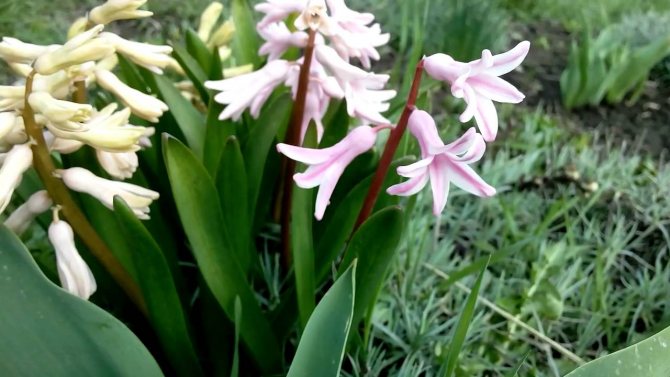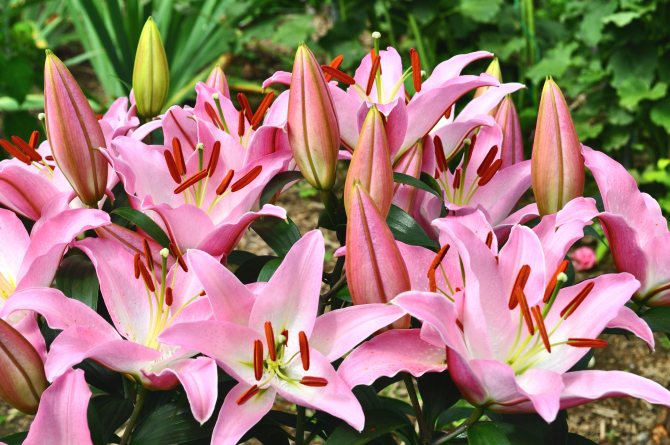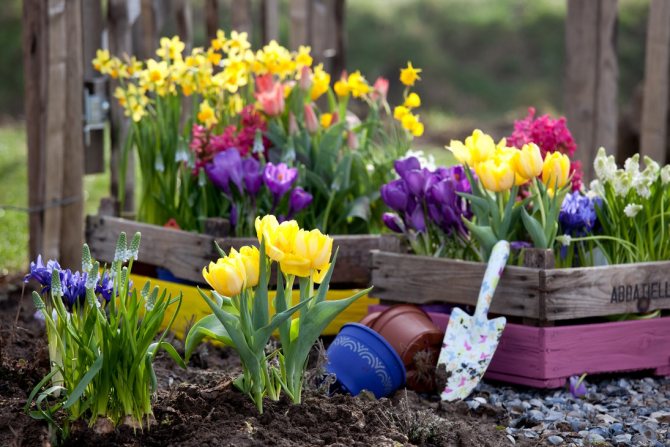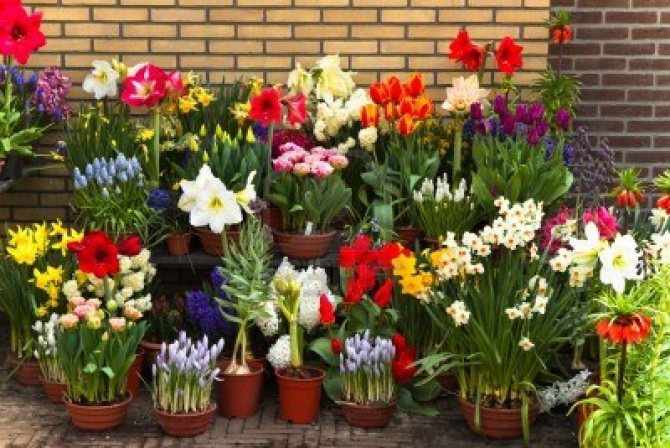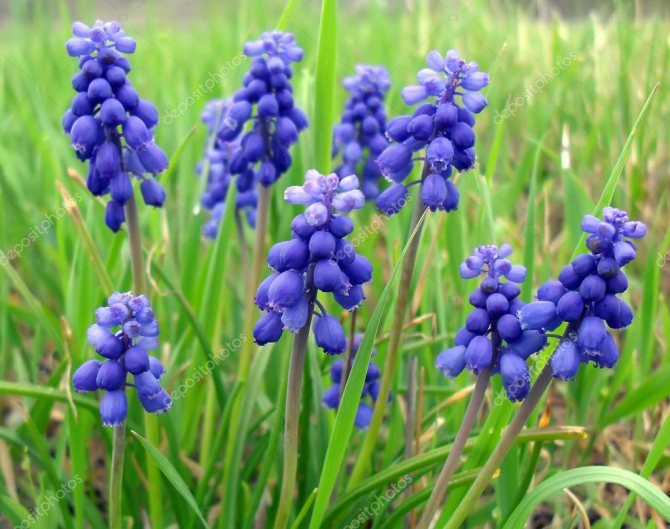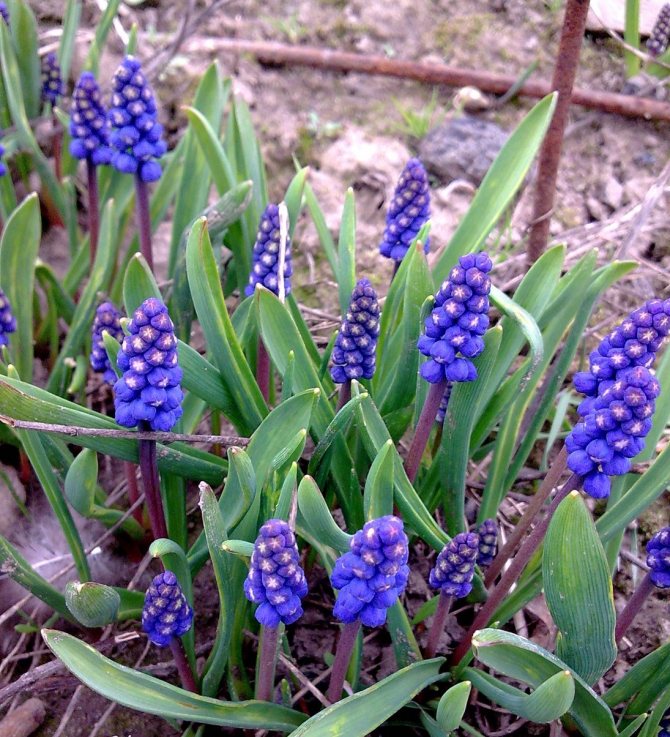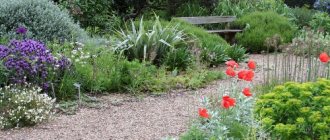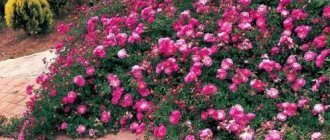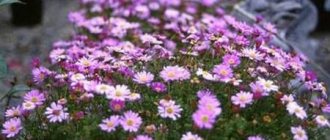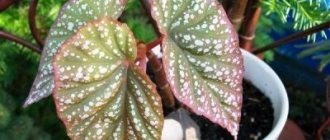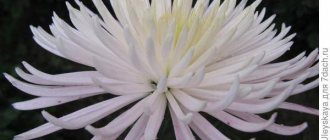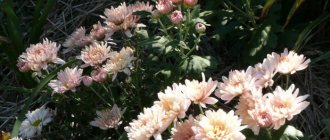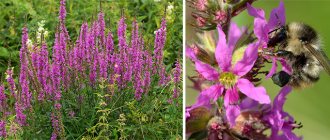Already in early spring, we direct all our brain energy to planning a summer cottage, picking up ornamental shrubs that should bloom and delight us with their aroma throughout the summer. This is understandable, because the time for flowers is coming, and, finally, there is such a rare opportunity to create your own happiness in a separate corner of the earth. Further, your attention will be presented a selection (names and photos) of the most decorative and beautiful perennial flowering shrubs for the garden and vegetable garden.
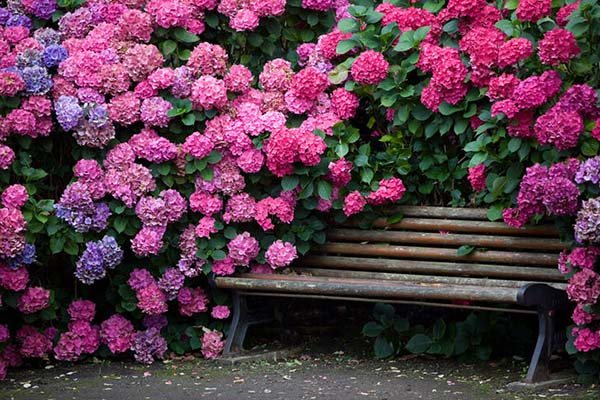
Where to plant bush flowers
Many will be surprised at this section, because they are used to planting any flowers in flower beds. But this is a stereotype. Shrub flowers can be used much more widely. Perennial flowering plants are used as a curb along garden paths. They form hedges, especially in those cases when it is necessary to hide your yard from prying eyes, and a blank fence will ruin both the appearance of the site and the mood of the owners.
A fashionable trend in recent years is the use of mixborders from conifers, perennial bush flowers and bright annuals in garden design. This is the name for mixed borders and flower beds from groups of plants of different heights, creating large color spots. Plants for them are selected in such a way that each season has its own decorative flavor. Correctly planted perennial bush flowers give mixborders a special charm, the main thing is that they smoothly replace each other without shading or suppressing neighbors.
How to plant flowers in a flower bed so that they bloom all summer - a diagram of the arrangement of varieties
With the correct combination of several types of color, it is possible for even an ordinary rectangular or round flower bed to become non-standard. This arrangement of flowers is also considered optimal when they are planted along the fence, at home. And if at the same time you know what flowers are blooming all summer, you can not worry about maintaining the attractive appearance of your flower garden.
Examples of planting schemes for creating flower beds blooming all summer
Even a familiar rectangular flower bed can easily turn into a work of art. But for work you need to use a variety of flowers and plant them according to the proposed schemes. You can find a good option in the following tips:
1 - Spikelet Liatris. 2 -Zopnik Ruselovsky. 3 - Echinacea purpurea. 4 - The small petals are beautiful. 5 - Yarrow ptarmica. 6 - Hybrid catnip. 7 - Fragrant rue. 8 - Oak sage. 9 - Carpathian bell. 10 - Renard's Geranium. 11 - Byzantine Chistess.
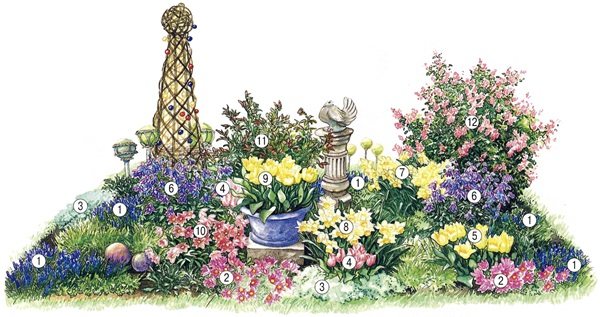

1 - Muscari. 2 - Common lumbago. 3 - Caucasian rezuha. 4, 5, 9 - Low-growing tulips. 6 - Watershed. 7, 8 - Narcissus. 10 - Eastern hellebore. 11 - Polyanthus rose. 12 - Small-leaved lilac.
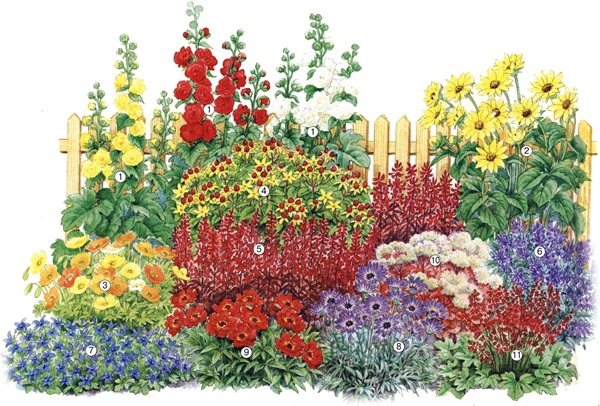

1 - Pleniflora. 2 - Ten-petal sunflower. 3 - Icelandic poppy. 4 - St. John's wort. 5 - Lobelia of Cardinal. 6. - Cattleman. 7 - Bell. 8 - Katananche. 9 - Perennial gravilat. 10 - Sedum matron. 11 - Geichera miracle.
After reviewing the recommendations for combining different varieties, it will not be difficult to understand how beautifully to make flower beds for flowers throughout the entire area. And if you wish, you can replace them with other colors that are similar in shape or color. You can also create a flower bed in just two or three colors. A white and burgundy flower bed will look sophisticated and unusual.A tandem of white with blue, blue or purple will make the site more "calm" and cozy. A yellow-red flower bed will help to give a sparkle to even a small and nondescript area.
Among the considered varieties of flowers with names, photos, you can easily find excellent perennials and annuals that will bloom all summer. It can be both unpretentious plants and very capricious varieties. The main thing is that they help create a bright and beautiful flower garden. Tips on the peculiarities of planting flowering plants, their combinations can be found in the attached diagrams and video recommendations. The offered flowers for the flower bed will help you create a unique landscape design of any site with your own hands.
Types and varieties of popular bush flowers. Tree peony
Peonies rightfully reign in garden beds. Bright and colorful, they amaze the imagination with a variety of varieties. Peony varieties are divided into 2 groups:
- herbaceous, with soft stems growing from tubers;
- tree-like, peonies are semi-shrubs, the trunks of which are lignified.
Tree peonies are ideal shrub flowers for the garden. They have strong, light brown stems, which not only persist after flowering, but grow every year. An adult bush becomes hemispherical, with dense, openwork, double-feather foliage. Flowers of huge diameter (from 12 to 20 cm) are located at the ends of the stems. Depending on the variety, there may be different colors and shapes: simple, semi-double and terry.
Conventionally tree-like varieties of bush peonies are divided into 3 groups:
- Sino-European. This includes varieties with large double flowers, which, at the end of flowering, fall under their own weight. Color options - from pale pink to bright fuchsia.
- Japanese. Here are collected bush flowers with smaller buds. The varieties look more light, the flowers seem to float above the stems.
- Hybrid. This group includes varieties obtained on the basis of yellow peony and Delaway peony. A very popular group with large yellow flowers.
All varieties of bush peonies are planted in autumn. A sunny, elevated place is chosen for the flower bed. The preferred soil is loamy. Clay soils are mixed with sand and fertilized. A peony bush can grow in one place for several decades.
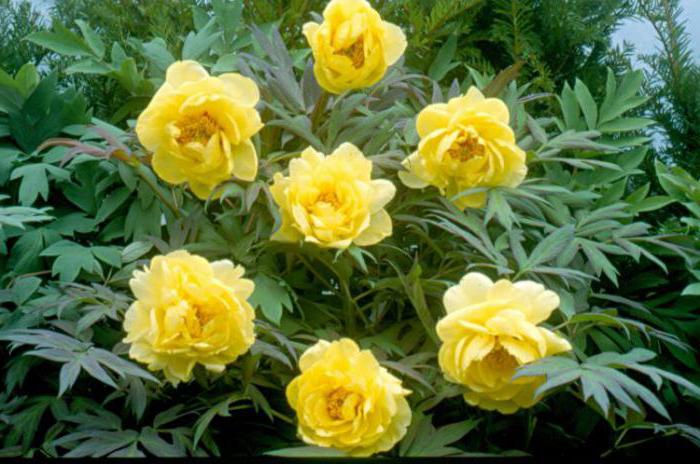

Watering is done 2 times a month. Up to 7 liters of water is poured under each bush. In August, watering is reduced and gradually stopped altogether. Weeds must be removed from the flower bed, and the soil must be loosened and mulched. Reproduction of handsome men is carried out by dividing bushes or cuttings. For the winter, it is better to cover the plants with spruce branches and foliage.
Catalog of perennial flowers for a summer residence: photo with names and descriptions of plants
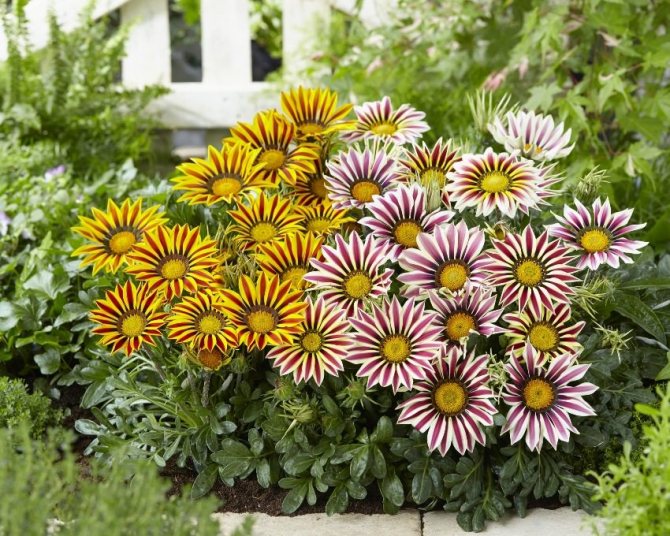

Gardeners call gazania South African chamomile
Hyacinths: planting in the open field and caring for perennials
Planting hyacinths and caring for them primarily comes down to the use of fertilizers. To obtain large and full flowers, dry-type fertilizing is used, which is introduced into the soil immediately after the first shoots appear, and the first loosening of the earth is done.
The second fertilization is done during the period when the buds were formed. This time, the fertilizer is fed to the root in liquid form. For the third time, feeding is carried out after the hyacinths have bloomed. This type of plant is characterized by special watering requirements. Do not allow the soil to dry out before the bulbs take root. The ground must remain moist. During the remaining period, when the shoots are already visible, watering should be carried out on a regular basis, especially in dry weather.
The first time after planting hyacinths must be watered abundantly.
Perennial gypsophila: planting, care, photos and plant features
Gypsophila has the appearance of a flowering shrub.Its delicate white or pink flowers cover the perennial abundantly, creating the effect of an airy haze. Photos of gypsophila, which can be found on the network, clearly show that this type of plant will look beneficial:
- in the background of the garden;
- at the walls of the retaining purpose;
- in the rock garden.
Perennial is characterized by increased resistance to winter cold. The main preferences are light soil with a high level of fertility and moisture, sunny terrain.
Helpful advice! Gypsophila is extremely vulnerable to transplantation. To increase the percentage of successful outcome, you should pre-treat the root system with a root stimulator.
Perennial gypsophila is excellent for planting on an alpine slide
Gladioli in the open field: planting and care, features of growth
The exquisite gladiolus is planted in an open area. In this case, wind protection must be present. It is not recommended to place perennials in areas where water can accumulate and stagnate.
In areas characterized by increased dryness and heat, gladiolus will need light shade. The midday sun can be detrimental, so flowers will need protection from high temperatures and direct sunlight. In areas with moderate climatic conditions, even a light shade can cause a drop in the level of decorativeness and delay in flowering.
Gladiolus reacts well to sandy loam soil, which must first be processed 20-30 cm deep and saturated with organic fertilizer.
Gladioli - traditional flowers in summer cottages
Gentian: photo, planting and care in the open field, features of handling a flower
The gentian is a perennial plant that blooms with blue bells. The active flowering period coincides with the summer season. This mountain flower is recommended to be planted on alpine slides. The group of perennials of this genus includes more than four hundred species and varieties.
Like all low-growing plants, the gentian needs a careful approach with regard to fertilization. A fertilizer high in nitrogen can harm the plant. Sun exposure should be dosed, but this does not mean that the flower should be placed in the shade. Dried shoots must be removed from the flower bed.
Gentian flowers are bell-shaped
Delphinium: photo and flower varieties
The seeds are laid in the soil in March. Landscape designers advise making a dense planting to keep the flower bed lush. After that, the flower bed is sprinkled with a layer of soil about 0.3-0.4 cm thick.
The category of perennials includes the following varieties of delphinium:
- Persian;
- large-flowered;
- holosteel;
- hybrid.
The flower loves regular watering, especially in dry weather conditions. The wet ground is then loosened, but very carefully.
Helpful advice! Delphinium loves root watering. The correct irrigation system will eliminate the appearance of powdery mildew (disease).
Delphinium - a moisture-loving flower
Dicenter: photo, planting and care ("broken heart")
In the photo of the perennial dicenter, you can see arcuate inflorescences dotted with heart-shaped flowers, which can be white, pink or light purple. In total, this genus has about ten cultivated plant varieties.
The most important condition for the successful cultivation of a dicenter is a correctly selected planting zone. In partial shade, it feels best, but a sunny area will also be an excellent place for a flower to live, provided that it is watered on time. The soil must be rich in mineral and organic composition. You can fertilize it with humus before planting.
Because of the shape of the flowers, di
Creeping tenacious: photos and features of perennial care
Gardeners love tenaciousness for its resistance to the negative effects of weather conditions.She does not show vulnerability to pests and diseases. Due to the dense flowering, even in conditions of minimal exposure to sunlight, the tenacious can be planted in specific areas of the summer cottage.
Scope of its application:
- decoration of rocky slopes;
- landing at the bottom of the green hedge;
- decoration of tree trunks around the circumference.
The procedure for seating, disembarking and replanting can be performed throughout the entire summer season. For plants, loose types of soil with an admixture of peat, sand or sod are good.
The creeping creeper can be planted on rockeries and stone slopes
Honeysuckle: photos, varieties, description of the perennial and caring for it
Honeysuckle is a shrub that bears fruit. There are a lot of varieties of this plant, but if you limit yourself only to those where edible berries grow, the choice will be between honeysuckle:
- edible;
- Altai;
- Kamchatka;
- Turchaninov.
The shrub is unpretentious to care for and can take root anywhere on the site where you want to plant it. The main thing is to have protection from the wind and a sufficient amount of sun.
Helpful advice! Honeysuckle does not like loneliness, as well as neighborhoods with specimens of the same grade. In both the first and second cases, the yield of perennials falls significantly.
There are many varieties of honeysuckle
Clematis: planting and care. Photo of a liana plant
Clematis can be a worthy decoration for any garden, suburban area or courtyard in a private house.
Perennial benefits:
- resistance to winter conditions;
- long flowering period;
- unpretentious care;
- durability.
Clematis is thermophilic and prefers the sun. Disembarkation is carried out with a step of 2 m. Low-lying areas or areas adjacent to groundwater are considered to be bad places. The soil must be selected loamy or sandy. In heavy soil, it is imperative to install a drainage system. In winter, perennials need protection.
Clematis has a long flowering period
Swimsuit: photos and landing features
To plant a swimsuit, preliminary soil preparation will be required. For good development of perennials, shade should be provided. In sunlit areas, the plant can also grow, but the abundance of light will cause the flowers to grind and fade quickly.
Soil requirements:
- looseness;
- humidity;
- the presence of drainage.
It is better to refuse to plant a swimsuit on sandy or dry ground. The flower needs regular watering, weeding, loosening the earth. Top dressing is also important. The best nutrition for the plant will be the dosed administration of nitrofroska, Agricola and urea in combination: a tablespoon of each fertilizer and 10 liters of water.
Swimsuit with large yellow buds
Kupena: photo of a perennial plant on the site
Kupena is considered one of the little-known garden perennials. The plant has a family relationship with Liliaceae. On its curved stem, there are greenish-gray leaves and small bell flowers hanging in droplets with a green border.
Areas with little or significant shade are the main habitat of the humble but attractive plant. The sun's rays slow down its growth and negatively affect the decorative characteristics of the purchase.
Note! This perennial has medicinal properties: it strengthens the immune system, speeds up metabolism.
Kupena does not like too sunny landing spots
Lakonos: photo, description of the perennial and the conditions for its cultivation
Lakonos is a large perennial plant. America is considered his homeland. During the summer growth period, the lakonos turns from small seeds into a lush bushy plant. The height can reach 1 m.By autumn, the peduncles are covered with black berries with a characteristic shine.
Both the juice of the plant and its berries are very poisonous. But this does not prevent gardeners from placing the lakonos in the very center of their compositions. In the middle of a flower garden, a perennial is unlikely to pose a danger. It can become a background addition to the fence, because open sunny areas are contraindicated for it.
Lakonos juice and berries are poisonous
Lilies of the valley: photos and care recommendations
A favorite place for lilies of the valley is moist soil, hidden under the dense shade of trees. Perennial perfectly tolerates prolonged absence of sunlight. But if the shadow is deep, the number of flowers will decrease. Instead, the lily of the valley will grow the deciduous part. Exposure to wind will also not be beneficial, reducing the number of flowers.
Helpful advice! Gardeners recommend planting lilies of the valley along walls and fences.
Hot weather conditions are detrimental to perennials. Don't forget about watering your plants. It is better to completely abandon transplants. A low fence around the flower bed will avoid strong overgrowth.
Lily of the valley flowers have a pleasant, persistent aroma
Daylilies: planting outdoors and caring for bushes
Shrubs sit in the planting pit. For a daylily, the depth of such a pit is about 20-25 cm, and the perennials themselves are placed in increments of 0.4-0.6 m. Before placing a bush in the recess, a little fertile soil should be poured onto the bottom. Moreover, this must be done in a slide. The roots will subsequently be straightened along it.
The zone where the transition from the root system to the leaves passes is called the "neck". It sinks into the ground by about 2-4 cm. The daylily requires abundant watering and mulching of the soil. It is recommended to cover the ground at the plant around a circumference of 4 to 7 cm. After planting, the plant will need to be watered and fertilized regularly.
Daylily blooms with bright inflorescences of various shades
Lupins in the open field: planting and caring for flower plantations
The decorative characteristics of this flower are very high. It is for the natural beauty that gardeners love lupines so much, planting and caring for which is a pleasure. The plant's exactingness to the soil is not high, but, as with other perennials, the rule applies here: the more fertile the land, the more magnificent and beautiful the plants bloom.
If you want to achieve optimal conditions for growing lupins, you should give preference to acidic types of soil. In such an environment, the plant improves the composition of the soil, independently forming a nitrogen-containing fertilizer on its tubers. To increase acidity, it is recommended to add sawdust and manure to the soil composition.
Fertilize the soil for lupins with sawdust.
Lungwitches: photo of flowers at their summer cottage and features of flower bed care
The lungwort, called pulmonaria among landscape designers, is distinguished by the beauty of flowers with a very early flowering period. Despite this, today it can not be found in every garden.
With the help of this flower, you can make a wonderful design of the site:
- live curbs;
- ridges along garden paths;
- ground cover addition to flower gardens.
Plant the lungwort in a cool and shaded place, and this plant can delight the eye with flowers, even in poor soil. Sandy composition is preferable. A perennial needs moisture and regular watering; mulching needs to be done for the winter.
It is necessary to plant lungwort (pulmonaria) in a shaded area
Euphorbia: photo of a garden flower, rules of care and cultivation
To plant milkweed in your garden, you need to take a sunny place. In extreme cases, the cultivation of a perennial in partial shade is allowed, but the flowering of the plant will not be so abundant.
Important! Heavy soils are a very poor base for planting milkweed. Growth slows down, and in winter the root system will rot.
Watering should be moderate.For the period of vegetative development, no more than two dressings are allowed with the help of fertilizers of mineral origin. The timely removal of dead inflorescences and pruning will help to preserve the external attractiveness of the green planting.
Euphorbia is often planted in the garden and in summer cottages.
Muscari: photo on a personal plot and characteristics of plants
This type of perennial belongs to the Hyacinth family. Even the muscari depicted in the photo is able to create a joyful and spring mood. For a flower bed in a summer cottage, it is difficult to find a more interesting specimen.
The bulbous plant is completely unpretentious. Muscari have earned their name due to their specific scent, which has similar notes to musk. Muscari is used by gardeners:
- Turgenevsky (light blue);
- Armenian (blue with white border);
- racemose (purple);
- aciniform (white, blue, blue-violet).
Muscari love abundant watering and sunshine. They normally perceive partial shade. Some varieties reproduce by self-sowing.
Muscari propagate by bulbs or self-seeding
Narcissus: planting and grooming outdoors
Daffodils in the company of tulips can be a beautiful addition to a personal plot. They bloom very early and are presented in a wide variety of varieties:
- onkel-like;
- tubular;
- small-crowned;
- terry;
- cyclamen;
- large-crowned;
- taceniform;
- poetic.
Planting plants is not difficult, the main thing is to guess the timing. The package usually lists the ideal month for planting daffodils. Prerequisites for care: regular loosening of the soil, watering (especially after flowering), removing diseased plants and jigging daffodils of a different variety.
There are many varieties and varieties of daffodils
Forget-me-nots: photos of flowers and perennial features
If you want to see what a bruner looks like, take a look at the forget-me-not flowers. The perennial blooms in late spring with light blue small flowers. After flowering, they are replaced by pointed leaves in the shape of a heart. These leaves have a sharp tip. Practically no special care is required.
Important! The plant needs moisture. With a lack of watering, the leaves will wilt. Therefore, the timing of watering should be carefully observed, and it is better to plant the perennial itself in clay soil, which constantly retains its moisture.
Forget-me-nots bloom in small blue and light blue flowers
Nivyanik: photos and features of a perennial
Nivyanik has many names: white chamomile, Roman grass, popovnik, white flowers. This flower is a frequent inhabitant of gardens and suburban areas. Perennial is characterized by high resistance to negative weather manifestations (frost) and unpretentiousness. Timely removal of baskets that have already faded will extend the flowering time of this amazing meadow plant.
Given the origin of the daisy, it becomes clear that the perennial prefers an open and sun-drenched area. Areas where water stagnates are best avoided. A properly grown chamomile can do without transplanting for 5, and sometimes 7 years.
Nivyanik is distinguished by its durability and unpretentiousness.
Liverwort: photo and characteristics of an evergreen plant
The herbaceous plant liverwort has another name - coppice. The perennial belongs to the extensive Buttercup family. Its habitat is considered to be forests in northern latitudes with moderate climatic conditions. In the gardens, you can meet only one species - the noble liverwort. Globally, there are thousands of varieties of this plant.
The liverwort has a long lifespan. Under the conditions of domestication and appropriate care, the plant can live up to 25 years. In nature, this indicator does not occur due to the fact that the liverwort needs moist and very fertile soils.
The liverwort (coppice) has a very long life span
Peonies in the open field: planting and caring for a flower bed
Peonies can often be found in parks and gardens. This light-loving perennial loves fertile soil. In optimal conditions, in one place, he is able to live up to 50 years.
For planting, you should select sunny, but protected from the wind areas of the territory. Peony bushes are prone to overgrowth, therefore, when decorating the paths, a certain distance should be left between the path and the planting pits. It is not recommended to plant a perennial under the walls of a building. Rainwater from the roof will increase soil moisture, and when the water stagnates, the root system of plants will rot.
Peonies grow in lush bushes with large flowers
Pyrethrum: a photo for lovers of garden daisies
If you see a colored chamomile in front of you, then there is pyrethrum in the photo. Planting and caring for these plants is specific, but simple enough. An unpretentious perennial grows well both in sunny flower beds and in shaded areas.
Note! In the absence of direct sunlight, the shoots of this plant can stretch out.
There are no special requirements for soil, but high humidity and poor soil composition can slow down the development of pyrethrum. Watering schedule should be regular, but in moderation. If you remove in time the peduncles that have already outlived theirs, the perennial will be able to bloom again.
Feverfew flowers are shaped like a common chamomile.
Climbing rose: planting and caring for the plant
Climbing roses are suitable for creating a romantic atmosphere in almost any area. This perennial cannot do without sunlight, so it is better to organize planting in an open area with a good level of ventilation. Swampy and lowland areas are not suitable for growing roses.
It is not recommended to break up the bushes in the place where the flower bed was previously, otherwise the plant will not take root. In order to avoid the death of roses, it is recommended to plant them on slopes or hills. This will relieve the soil in the growth zone of bushes from waterlogging, which often occurs during rainy periods or in areas with groundwater lying near the surface.
A climbing rose is planted near fences, pergolas or arches
Perennial primrose: photo, care and planting of a plant
The primrose is called the primrose because of its early flowering. It is for this that she is a favorite perennial of summer residents and gardeners. In the photo of a perennial primrose, there are purple, yellow, red and blue flowers.
Note! This type of plant is widely used in folk medicine.
Before planting, it is worth introducing fertilizers into the soil. The earth must be moist. Garden outskirts with good shade are best suited for these purposes. The plant takes root well under pears and apple trees. Cool conditions are considered optimal. Humus from last year's foliage can be used as food.
Primula is one of the earliest flowering perennials
Perennial rudbeckia: planting and caring for a flower bed
The variety of rudbeckia is varied. The plant has similarities to chamomile. Their petals bent to the bottom can have different colors:
- yellow;
- blue;
- lemon;
- brown;
- orange.
The plant is not demanding in terms of land. Feels better on well-groomed soils, fertilized with humus and with high water permeability. The growth period of a perennial in one place without transplanting is 5 years.
During the growing season, feeding in the form of potassium sulfate and nitrophoska is recommended. Dead flowers must be removed, as well as young growth (as needed, if the bushes are heavily overgrown).
Rudbeckia can grow in one place without transplanting up to 5 years
Yarrow: photo of an unpretentious and medicinal plant
Yarrow is very popular among the owners of suburban areas involved in flower bed decoration. Its inflorescences have a bright color (red, white, pink, orange, cherry, yellow), retain their attractiveness for a long time, and the plant itself is considered medicinal.
There are almost two hundred varieties of this perennial. The places of its natural habitat are mountain meadows, rocky and rocky terrain, glades, which ensured the high resistance of the plant.
Note! Yarrow is not only able to withstand sudden temperature changes, it can tolerate periods of prolonged drought normally.
Yarrow has medicinal properties
Perennial phlox: photo, planting and care of flower beds
Thanks to the efforts of breeders, the variety of phlox has increased, and these unusually beautiful plants have become indispensable inhabitants of decorative flower beds in suburban areas. Even a little care makes phlox bloom in lush colors.
The plant is able to take root even on heavy soils. To do this, you just need to add sand with coarse grains to the bottom of the planting pit. In sandy soils, a layer of clay will not interfere. Planting phloxes is carried out 2-3 cm deep into the ground (the root collar is buried to this depth). For good flower development, you will need an open area with sun and protection from the winds.
Phloxes grow in lush and bright inflorescences
Hosta: species and photos with the name of the varieties
The plant loves the shady coolness of gardens and does not need careful maintenance, as evidenced by the beautiful photos of the host in the landscape design of suburban areas. The decorative perennial has many varieties:
- Christmas Eve;
- White Christmas;
- Alex Summers;
- Mango Tango;
- First love, etc.
You can easily get confused about the variety of plants, since many of them are based on sports (shoots that differ significantly from the maternal perennial).
Note! Sandy soils slow down plant growth. Moreover, the composition of such soil enhances the color of the leaves. The recommended soil condition is shade and moisture.
Hosta variety "Tango Mango", planted in a flower pot
Perennial garden chrysanthemums: planting and care, photo
Chrysanthemum has a 3-thousand-year history. It was first domesticated for horticultural purposes in China. The plant is characterized by lush flowering. To achieve this result, it is necessary to choose the right time and place for planting.
When the perennial is in the ground, the first pinch is done. In other words, growth points are removed. This procedure is repeated three weeks later and the upper part of the shoots is removed. Chrysanthemum reacts poorly to lack of moisture and does not like thick shade.
The best landing site is a hill. Requirements for the soil: looseness, moisture permeability, fertility. Peat, compost, rotted manure will not hurt.
With proper care, chrysanthemum will give a lush bloom
Stock rose: photo, specificity of this plant
The stem rose is distinguished by its beautiful flowering and photophilousness. Therefore, it should be placed in an area that is well lit by the sun. The shade will not only delay the growth and development of the perennial, but it can also cause the lack of flowers. Moreover, the plant can be in this state for two years. Poor and dry soils are also not desirable.
The watering scheme should be moderate, because a large amount of liquid can provoke rotting processes in the roots. The soil should be fed with nitrogen-containing fertilizers. Dead flowers cause depletion of the stem-rose, so you need to get rid of them.
Stock-rose loves sunny places and moderate watering.
Having studied the characteristics and features of each of the plants presented in the catalog, you can learn how to form unique flower arrangements. Many perennials have similar planting, feeding and watering requirements.Based on this information, you can create accurate layouts for beautiful and colorful flower beds.
A source
Types and varieties of astilba
The bush astilbe looks very beautiful in the garden, which loves partial shade and moisture. Many varieties are suitable for garden plots:
- Astilba is Chinese. Bush up to 1 m tall with pinnately dissected elongated leaves. The edges of the leaves are slightly serrated. Chinese astilbe has small flowers that are concentrated in lush apical inflorescences. The colors of this species range from pale lilac to lilac-pink.
- Japanese astilba. A low bush (up to 40 cm), with complex pinnately dissected dark leaves. Paniculate inflorescences are collected from small white flowers.
- Astilba David. The tallest bush flowers of this species (up to 1.5 m). In the wild, they are found in Mongolia and China. The bushes are spreading, the leaves on them are light, feathery. Inflorescences are large, color from pink to lilac.
- Astilba Arends. This is a whole group of hybrid varieties based on David's astilba. Bushes with high peduncles of various colors. They are appreciated for their decorative effect and duration of flowering.
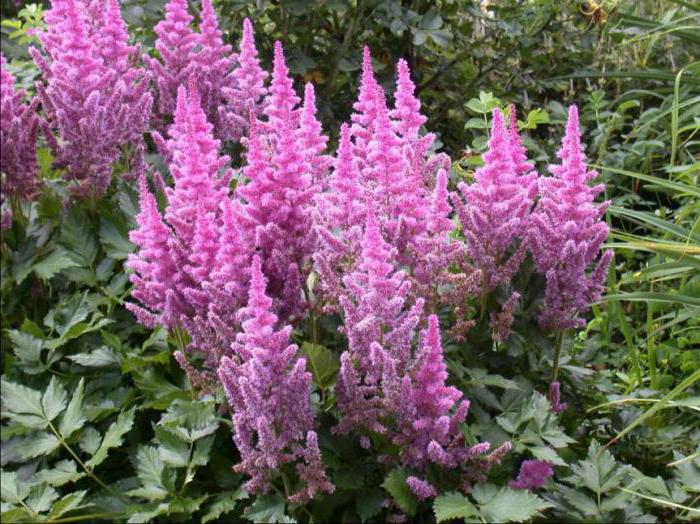

When planting astilba, a distance of about 50 cm should be maintained for tall varieties, up to 30 cm for low varieties. Before planting, the soil for bush flowers, the photos of which look very bright and elegant, are fertilized with compost and rotted manure. The plant loves watering and mulching. It is better to cover for the winter, because with spring weather drops, astilbe can die. The plant is propagated by dividing the bushes, buds or seeds.
Biennials for open ground
Herbaceous biennials live for two years. In the first year, the main vegetative organs are formed - the root and stem with leaves. And in the second year - generative, a peduncle and seeds appear. Unlike perennials, biennials do not have modified underground shoots - bulbs, rhizomes and tubers.
Biennials include most garden root crops, as well as valuable medicinal plants - speckled hemlock, marsh thistle, blue cornflower, motherwort variegated.
Hemlock
Hemlock speckled is a tall herbaceous plant with white umbellate flowers from the Umbrella family. When collecting medicinal raw materials, it is important to distinguish hemlock from other plants similar to it. If you pluck the hemlock leaves or flowers and rub them in your hands, they smell like a mouse's nest. On the trunk, red droplets are visible, similar to droplets of blood.
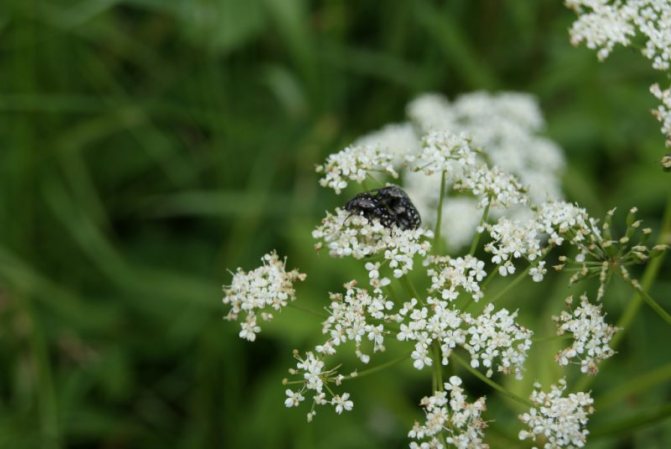

Hemlock speckled is a representative of plants from the umbrella family.
In nature, the grass grows on flooded meadows and forest edges. Most often it enters vegetable gardens as a weed, but it can also be used for medicinal purposes.
Hemlock is used to treat various ailments - to combat oncology, seizures and spasms.
The patch and extract are used as an external anesthetic.
Bodyak marsh
Thistle is a biennial or perennial plant from the Asteraceae family, in which more than 400 species are known. Such grass grows in meadows and fields, it is considered a weed, as it penetrates into crops. Some types of thistle are used in folk medicine, grown as ornamental and vegetable crops. Its inflorescences are rounded baskets with tubular flowers of crimson or purple color. This plant is a good honey plant.
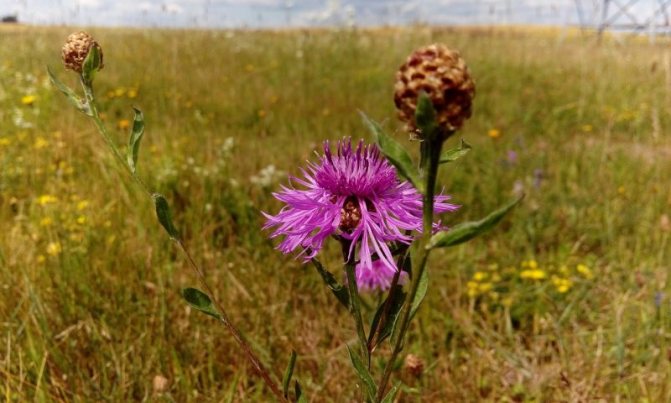

Prefers moist soil.
- Marsh thistle has a thorny stem and thorny leaves.
- Plant height - from 50 cm to 2 meters.
- Leaves pinnately dissected on short petioles, with thorns along the edge and pubescence on top.
- It blooms with purple, rarely white flowers.
The plant loves moist soil, grows in Siberia and on the European part of the continent in swampy forests and river valleys.
Cornflower blue
Blue cornflower from the Asteraceae family is an excellent melliferous plant and a valuable medicinal plant. Bees make thick honey from the nectar of its flowers with a pleasant almond scent.Blue cornflower grows in nature in the Caucasus, Siberia, Central Asia and the European part of Russia.
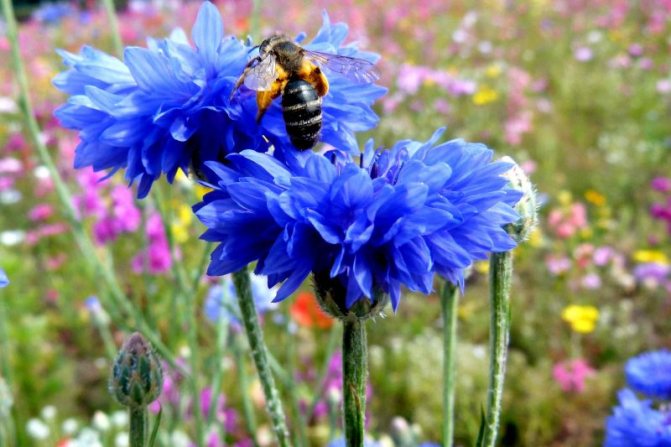

Blue cornflower is a medicinal plant.
For medicinal purposes, the petals of its flowers are used as a choleretic and diuretic.
Broths of cornflower are used for coughs, nervous and gastric diseases, they make lotions for the treatment of eczema and ulcers.
This unpretentious flower is grown as an ornamental plant in a flower bed. It can be sown as seeds directly into open ground. Cultivated varieties bloom not only blue, but also white, pink, burgundy flowers from June to September.
Motherwort varifolia
This herbaceous plant from the Lamiaceae family prefers clay-sandy soils rich in nitrogen. It has a taproot and green stems with a reddish-purple tint, 50 cm to 1 meter in height. Purple small flowers are collected in the axils of the upper leaves, forming a spike-shaped inflorescence. The plant blooms in June or July. In Russia, it is found in the Far East and Eastern Siberia.
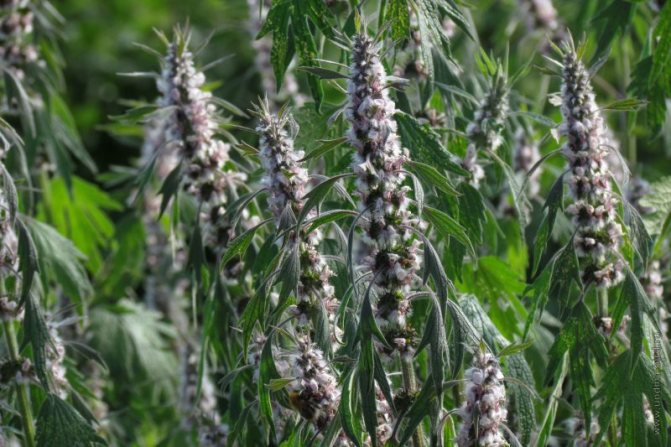

Motherwort is an excellent remedy for headaches.
The stems, leaves and flowers of motherwort are used for medicinal purposes. An alcoholic tincture of the plant can be purchased at a pharmacy. It is used as a sedative for nervous diseases, as well as an antispasmodic for spastic pains, coughs and convulsions.
Function
The second name is the hybrid host Halcyon. This is an ornamental deciduous perennial bush flower. The peculiarity of the species is medium-sized, basal, petiolar leaves of a blue-green color. Flowers - funnel-shaped bells in racemose inflorescences. The size of each flower is no more than 5 cm. Color - lavender blue. Peduncles are tall and devoid of leaves.
The function blooms from mid to late summer. Loves shade and partial shade. To enhance the decorative qualities (the size of the leaves and their color), it requires abundant moisture. With a lack of moisture, the tips of the foliage darken at the funkia.
The flower does not require complex care. It is necessary to moisten the soil in time, fertilize it and carry out mulching. In the fall, pruning of shoots and removal of dried leaves and peduncles is performed. Since the variety is frost-resistant, it is not necessary to cover the plant for the winter.
Winter worries
Now about the winter period: those bulbs that can be left in the ground for the winter often do not require additional shelter. In regions with severe winters, it is still advisable to cover them with spruce branches or sawdust. Wintering perennials are recommended to be transplanted once every 3-4 years, in order to rejuvenate the plants and separate the formed children. Bulbous and rhizome perennials that need to be dug up for the winter (gladioli, dahlias) are advised to be stored until spring in a vegetable refrigerator box or in a vegetable store.
Some perennials that winter well in any conditions need to be dug up in the summer after their ground part dries up, dried in a dark, ventilated room and planted in a permanent place before frost. This should be done approximately once every 2-3 years. Such a specially created dormant period will give the next year a large flowering and rejuvenation of the plant.
Shrub roses. Planting and leaving
Shrub rose is a popular plant at all times. It gives a special charm to front gardens, flower beds and gazebos. The plant can look like a classic tall bush, like a lovely bouquet, surrounded by greenery, like a flowering waterfall. The bush rose is beautiful in all its forms.
A shrub rose is planted in prepared soil, which consists of garden soil, peat and bone meal supplements. The size of the planting hole is matched to the size of the root system of the seedling. In the hole, the roots should not bend and curl, the direction of the roots is strictly downward. The earth is filled up evenly, there is no need to tamp the hole strongly. The top layer is slightly loosened and watered abundantly with water. A layer of peat is laid out on top.When the flower grows up a little, it is necessary to huddle and mulch.
The appearance of a bush rose always depends on the quality of its care. In the spring, pruning of excess and weak branches is mandatory. This manipulation is performed after a slight swelling of the buds on the bush. For the winter, the bush rose must be covered. To make the bush look lush and beautiful, all dried leaves and buds are removed. Watering is required in moderation, but only with warm water.
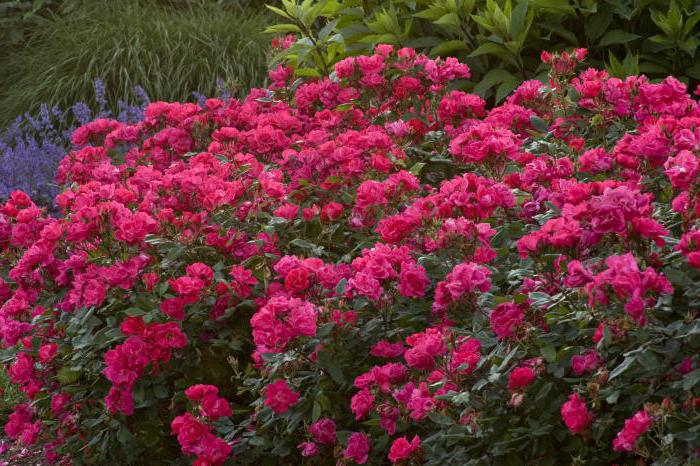

Features of growing bulbous
- • Most bulbous plants are planted in well-lit areas with light, lush, water and air permeable soils that are nutrient-rich and neutral.
- • Spring bulbs (blooming in spring) are planted in open ground mainly in September-October, summer bulbs (which do not winter in our conditions) - in April-May.
- • Planting depth should be equal to three times the height of the planting material. Typically, the distance between large bulbs in a row is 10-15 cm, small bulbs and “children” are planted denser.
- • Most bulbs are winter-hardy, but daffodils and hyacinths can freeze out in snowless winters, so for the winter they should be covered with mulch (peat, straw, needles or fallen leaves). This is done in November, when freezing temperatures and the ground freezes a little. Mulching material is removed in the spring, when the threat of spring frosts has passed.
- • After the plants have bloomed, flowers must be removed - they "steal" the nutrients necessary for the development of the bulbs.
- • Most spring bulbs cannot be left without transplanting for 4-5 years or more. Nests are usually dug and divided in June after the leaves have dried.
- • Summer bulbs are dug up in October, dried for 2-3 weeks, then they are cleared of the ground, separated from the "kids" and stored until planting.
Shrub roses. Types and varieties
Roses are unique bush flowers, the names and types of which are very diverse. For convenience, they are divided into several species groups:
- Park. This is a group consisting of forms and varieties of cultivated rose hips. With proper care, park roses form dense spreading bushes up to 1.5 m tall. These bushes bloom for about a month, the beginning of flowering occurs in June. The color of the flowers in the group is varied: white, pink, purple, and so on.
- Shrub. This is an actively growing group of plants. The height of the shrub can exceed 2 m. Flowers (spray roses) are semi-double and double in shape. The color scheme is very diverse.
- Polyantova. These are undersized bushes with lush inflorescences. The shape of the flowers is double and semi-double. It is valued for its long, abundant flowering from June to late autumn. Polyanthus roses do not smell.
- Floribunda. This is a hybrid group resulting from the crossing of polyanthus and hybrid tea species. The group has inherited the best parenting traits. The bushes are frost-hardy, constantly blooming, with a huge color palette of double flowers and a delicate aroma.
If we consider bush flowers for the garden, perennial roses can be considered a very worthy option. They are suitable both as an independent decoration and as part of a landscape composition. Such a variety of colors, varieties and types, perhaps, will not be found anymore.
Types of bulbous perennials
Perennial garden bulbous flowers include many types of plants that differ not only in external characteristics, but also in the flowering period.
There are several types of bulbous perennials:
- corms;
- small-bulbous;
- bulbous.
All of them belong to perennials, the underground part of which (bulbs) retains all the necessary trace elements and nutrients for the growth of flowers.
When choosing perennials, you should pay attention to the seasonality of flowering in order to ensure its continuity when laying out the site:
- Spring specimens and primroses.The earliest flowers include such perennials as crocus, blueberry, mascari, snowdrop. With the onset of warm weather, daffodils, tulips, irises and hyacinths bloom.
- Summer bulbous. In the summer months, larger flowers can be observed in the flower beds with a stunning aroma and a variety of color palettes. These are lilies, dahlias, daylilies, callas, gladioli, freesias, etc.
- Autumn perennials. Flowers that are not afraid of a cold snap and continue to delight the eyes of others - crocuses, crocuses and cyclamens.
In order to choose the right varieties, you need to carefully study not only the characteristics of bulbous perennials, but also consider their photographs. This will help in creating an original planting that will bloom almost without stopping.
Perennial bush carnation
Garden bush carnations are used for beds, flower beds and borders. The correct name is "Dianthus", which translates as "flower of god". The shrub carnation belongs to the carnation family. Wild forms can be found in Europe and North America. The height of the bush is from 10 to 55 cm. The color of the flowers is white, red, hot pink purple or red. The color lasts 3-4 months.
Shrub carnation loves sunny and semi-shaded places. The landing site must be protected from wind and drafts. The flower does not like excessive watering. The garden beauty is propagated by seeds.
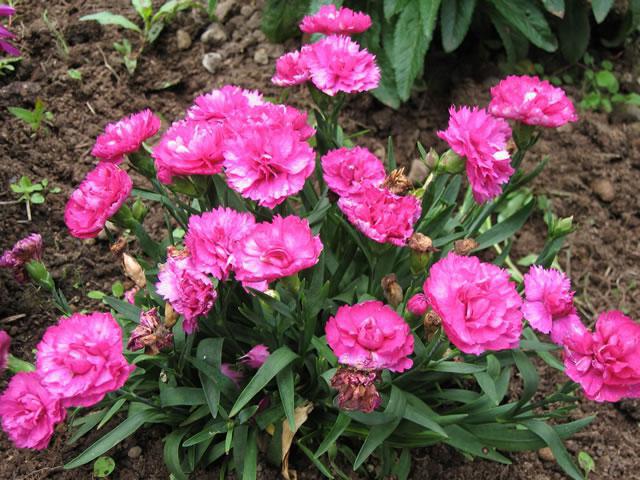

Classification of flowers by bulb type
There are three types of plants according to the type of bulb:
- Bulbous, which include irises, amaryllis, liliaceae in all their variety;
- Small-bulbous, which include most primroses;
- Corms, in which the underground thickening of the stem forms a corm. These include gladioli, ixia, crocus.
All plants, united by the common name bulbous perennials, striking at different periods with the brightest colors and unique forms of bouquets, can create the effect of continuous flowering, correctly selected and planted taking into account their needs. To give a short description of plants of this species, provide photos and names, indicate the features of planting and care - the purpose of this article.
Phlox
A bright decoration of many flower beds from early spring to late autumn are bush flowers, perennial, the name of which is phlox. These are moisture-loving plants with branching adventitious roots that do not like close proximity to groundwater. Therefore, for phloxes, a high bed is created, the so-called earthen cushion. The place for their landing should be sunny, in extreme cases, light partial shade is allowed. The density of the inflorescences depends on this. All types of phlox require watering and feeding. It is imperative to loosen the topsoil. For winter, the plants are covered.
All the numerous species are formed into 4 groups:
- tall bush plants (from 90 to 180 cm);
- less tall bush plants (from 40 to 70 cm);
- low bush plants (25-30 cm);
- ascending and creeping species.
Phlox in the garden not only looks good, but also smells very good.
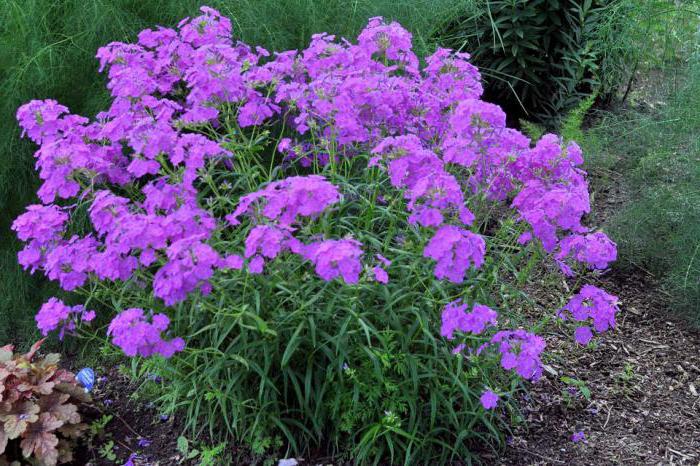

Spring bulbous perennials
Spring bulbous perennials are filled with special tenderness. It is they who attract the attention of passers-by, blooming in early spring, when almost all nature has not yet awakened from sleep.
Tulip
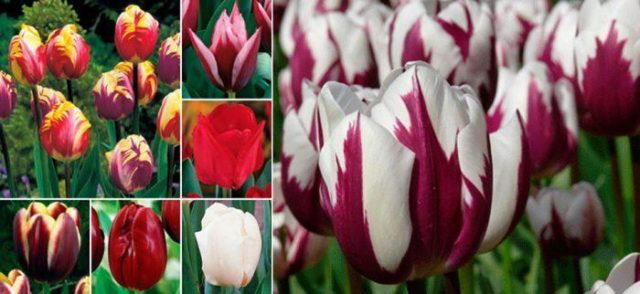

Bulbous perennials, native to Asia, bloom in early May, although there may be some factors that change the timing of flowering (climatic conditions of the region, the amount of moisture, etc.). The species differ not only in color, but also in height (from 10 cm to one meter).
There are several colors of tulips that can be seen in the photo:
Narcissus
Another common representative of bulbous perennials is the daffodil, which is represented by 60 species. However, in the middle lane, just over 25 varieties of this flower are grown.Flowering can begin in mid-April, but no later than early May.
Types of daffodils:
- Tubular;
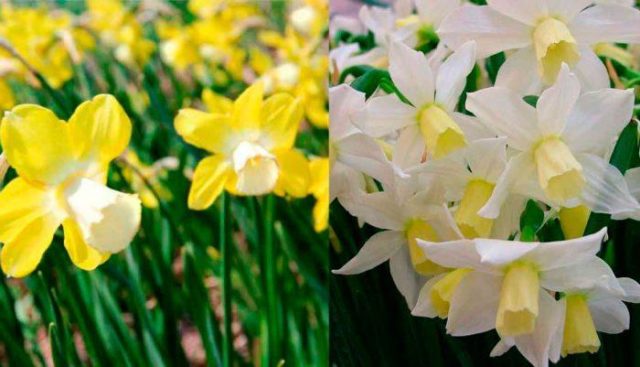

Important! This variety is considered the most popular and common among flower growers. It does not need special care, is resistant to spring frosts, does not require top dressing and frequent watering.
- Large-crowned;
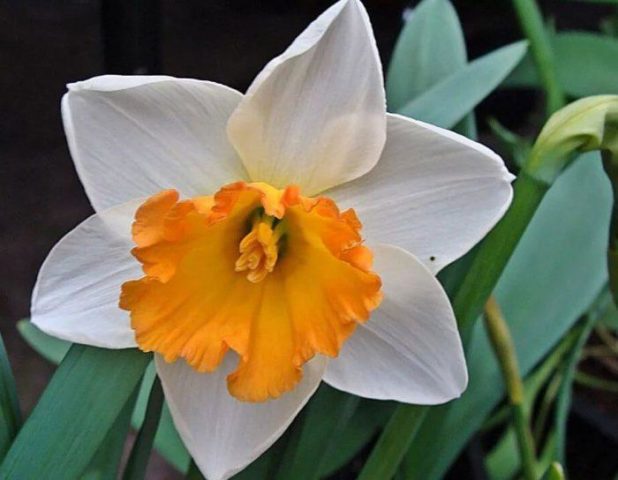

- Small-rooted;
- Terry;
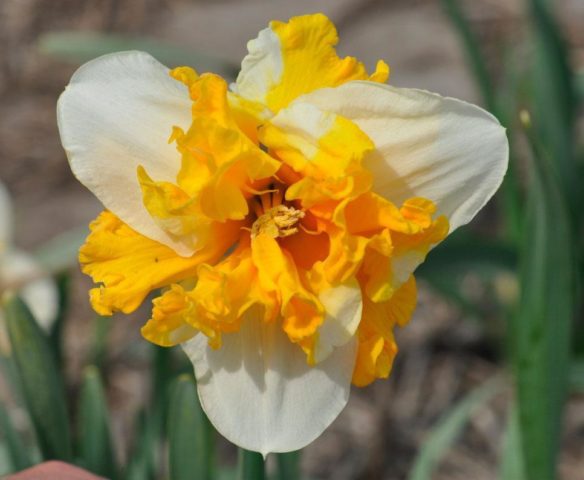

- Triandrus;
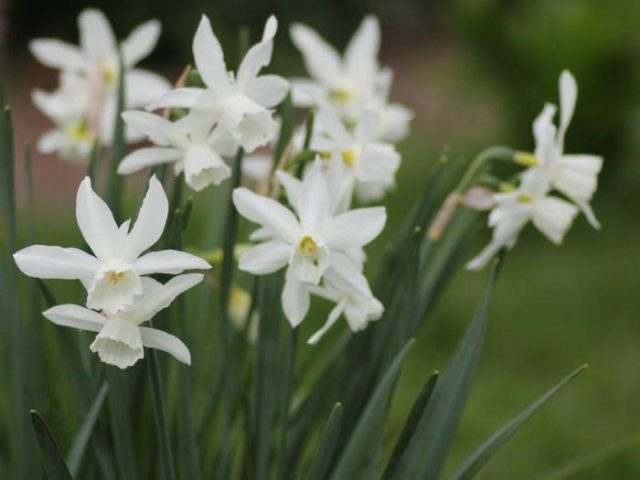

- Cyclamenous;
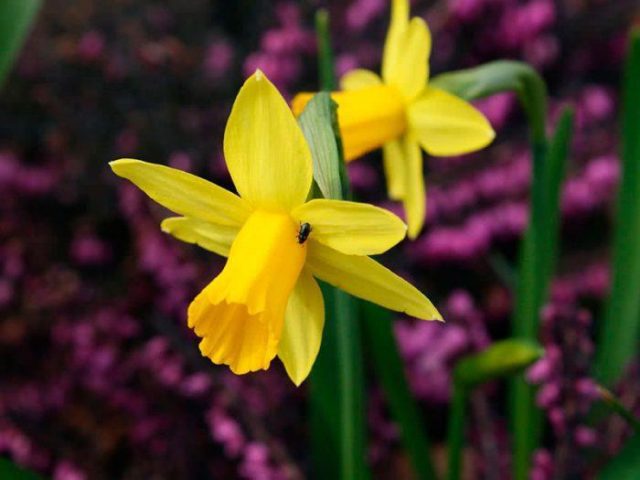

- Jonquillium;


- Poetic.
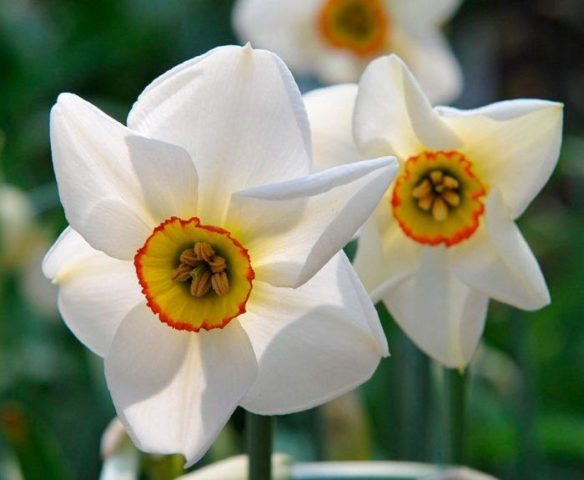

In addition to these species, there are many more hybrids, some of which are not even included in the State Register of the Russian Federation.
Hazel grouse
Fritillaria, or hazel grouse, also refers to the perennial bulbous flowers that bloom in the spring. The flowers got their name because of their appearance and color. The plant can also be compared to a palm tree, the top of which is decorated with original buds. Among the people, the hazel grouses have a different name - the paradise tree, which has about 150 species.
The most popular varieties:
The hazel grouses can bloom for a month, but it all depends on how much sunlight will come to them. Therefore, it is best to plant this perennial in lighted areas.
Attention! The brighter the light, the richer the colors of the buds will be.
Crocus
Saffron, or crocus, has over 300 varieties, most of which bloom in the fall. But there are also early varieties that bloom their buds even during the period when all the snow has not yet melted. The bulbous crocus is not afraid of frost and precipitation in the form of snow, therefore it is a constant inhabitant of many flower beds.
Among the most common species of this perennial are:
- Spring;
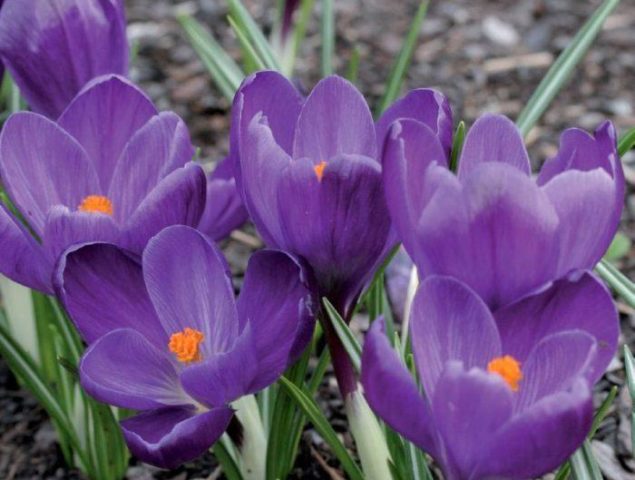

- Two-flowered;
- Golden;
- Thomasini.
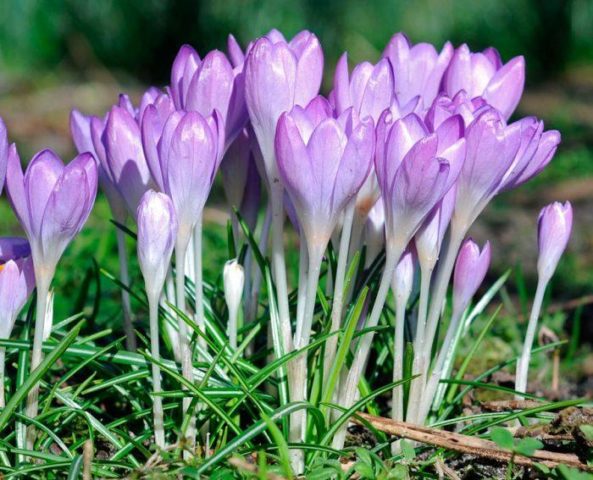

Chionodox
It is a perennial undersized bulbous plant that is found in only 6 species. It got its name from two Greek words - snow and pride. Among the people, he has his own name - "snowy beauty", or "snowman". The flowering culture begins very early, at the moment when snowdrops make their way through the thawed patches.
- Chionodox Forbes;
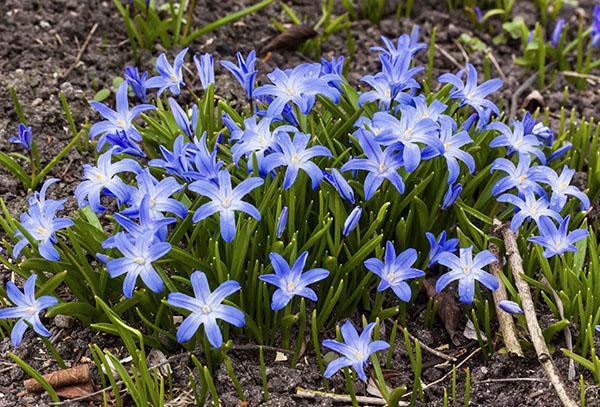

- Sardinian;
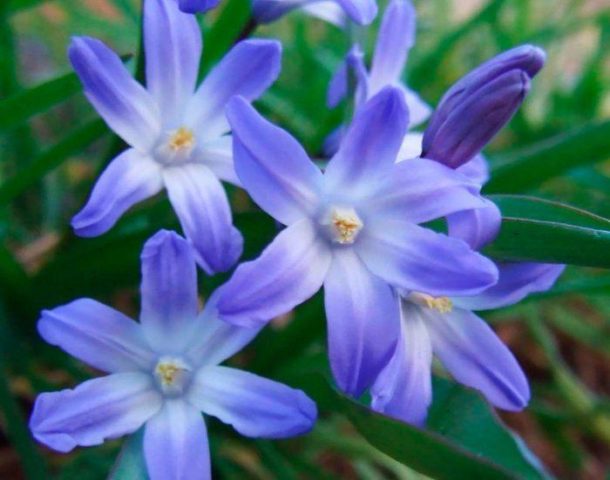

- Chionodox Lucilia (giant).
The plant does not like to grow with other bulbous perennials, so it should be planted away from them. But the neighborhood with weeds and other plants does not bring him discomfort. In addition, Chionodoxa does not need special care, it is enough to apply top dressing in the fall, watering is needed only in case of dry weather.
Important! Pest protection is also not required for the crop.
Lilac
People have long been accustomed to lilac bushes in parks and plots. But it turns out that more than 30 species belong to this genus of shrubs. The most common species on our sites are common lilac, Amethyst, Himalayan and Hungarian lilacs, white varieties - Defenders of Brest, Galina Ulanova and Vestalka. Different types of lilacs bloom at different times. These varieties of bush flowers do not require special care. Suffice it to simply abundant watering and mulching with peat. In the second or third year, fertilizers are applied under the bushes.
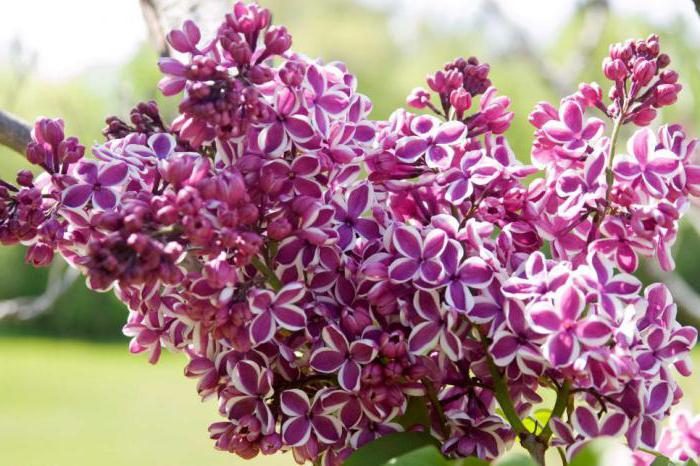

Bulbous perennials that bloom in autumn
Autumn bulbous perennials are a real decoration, stars against the backdrop of yellowing nature. Many of them bloom until the very cold, despite the slushy weather, numerous rainfalls and other features of the autumn period. Perennial flowers, the bulbs of which contain the substances necessary for growth, are stocked up with the greatest amount of "food" in the fall, so they can safely endure wintering and all the negative effects of the environment.
Colchicum
Autumnal, colchicum or colchicum - all these are the names of the same flower, which opens its buds at a time when most of the plants have already faded. Colchicum is unpretentious. He needs only rare watering, which must be carried out exclusively during flowering. If the weather is rainy, then this stage can be easily skipped.
Kolkhikum has several types, but the following are the most common varieties:
- Colchicum Hungarian;
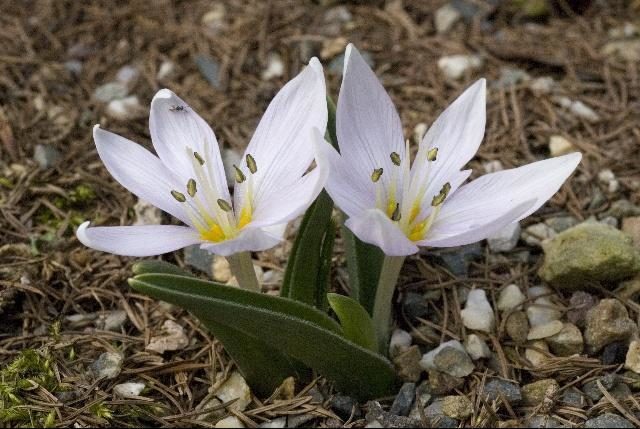

- Colchicum Ankara;
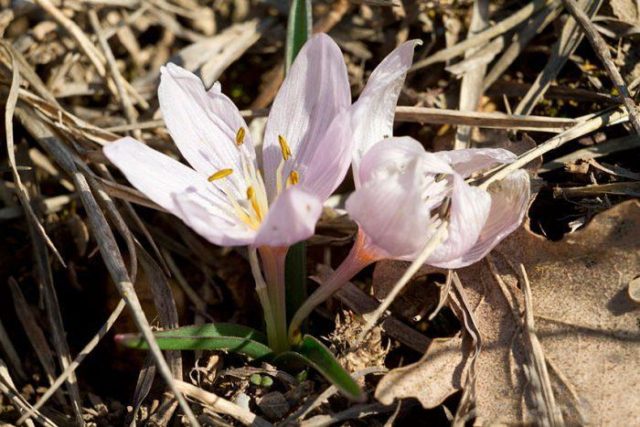

- Colchicum of Regel;
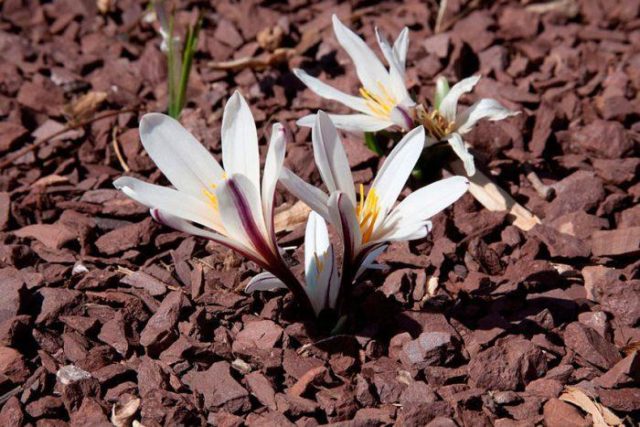

- Autumn;
- Colchicum is magnificent. Columbus bloom begins in September (usually after the 20th numbers) and continues until severe frosts.
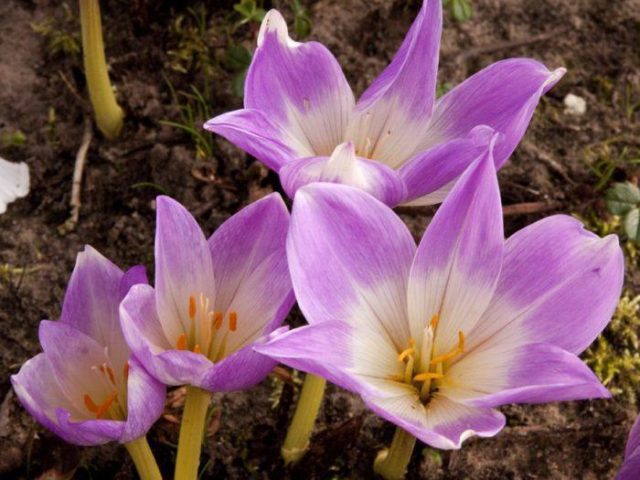

Garden cyclamen
Dryavka, or alpine violet - this is how the people call small flowers that are lined with carpeting and against the general background of autumn nature and seem to be something outlandish. In addition to their beauty and elegance, cyclamens also amaze with a fragrant aroma that can be felt a few meters from the flower bed:
- Cyclamen neapolitan. The first buds of this bulbous representative can be seen in late September and early October;
- Kosky. This bulbous flower will bloom at the end of September;
Hydrangea
In August, the gardens are covered with white foam of blooming hydrangeas. Most often it is a tree hydrangea. The height of the shrub can exceed 2.5 m. Small flowers are collected in large balls of inflorescences. Despite its high decorative qualities, hydrangea is unpretentious. She is not afraid of frosty winters. Requires regular, moderate watering and pruning. A huge minus of the snow-white beauty is that all parts of the plant are poisonous. Care must be taken.
The use of bulbs in landscape design
Bulbous flowers are suitable for creating early spring, summer and even autumn compositions. The most decorative look is group plantings (both homogeneous and mixed, created from various varieties or species of plants). Flower beds have an amazingly beautiful look, where all plants bloom at the same time and are of the same height. The entire flower garden must be evenly lit, otherwise some flowers will bloom earlier, others later. Low-growing plants are placed in the first rows of compositions to create borders, and tall plants are placed at a distance or in a distant corner of the flower garden.
Create a landscape
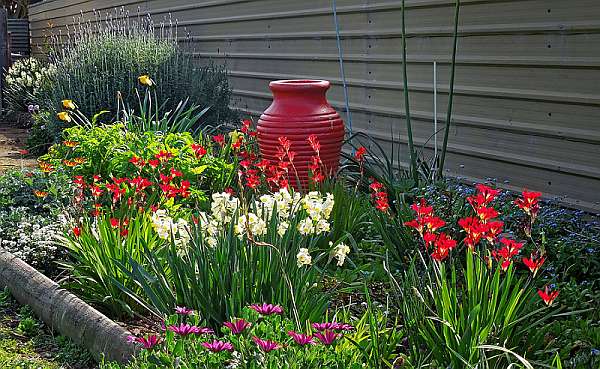

When creating landscape compositions for bulbous plants, you need to choose a good background. They look very good in groups on lawns, especially near small evergreens (boxwoods, junipers, etc.). For such a background, you can use stones, driftwood.
Spring bulbs do not please us for long - their aboveground part dies off until mid or early June, so it is advisable to plant them together with other perennial herbaceous plants (irises, hosts, geyher, peonies, badan, anemones, ferns, arabis, stonecrops, daylilies, gypsophila and others), which will bloom later and cover the “empty spaces”. For the same purpose, decorative annuals (tagetis, salvia, esholzia, alissum, verbena, petunias, ageratums, etc.) are often used, they are planted between bulbs. Sometimes in flower beds among perennial plants, empty spaces are left, which are planted annually in autumn with bulbs, and after flowering they are dug up. If the flower garden is decorated only with bulbous, after flowering they are dug out annually, and decorative annuals are planted in the vacant space. In the fall, when annual plants die off, bulbs are planted again. Then your flower garden will always be blooming.
Gaillardia
Perennial Gaillardia belongs to the Aster family. This is a drought-resistant bush flower with single inflorescences-baskets. The marginal flowers of the basket are red-purple, the middle ones are orange or dark red. Perennials can have baskets of simple, semi-double and terry shapes. Gaillardia should grow in a lighted area. Watering these bush flowers is required only during dry periods. The rest of the care is the garter and the removal of dried parts. Reproduction - self-seeding, seedling and dividing the bushes.
If you want to have a paradise on your garden plot, we recommend planting bush flowers, perennial.The names of the plants most commonly used to create a garden landscape have been described in this article, but the list is endless, since nature has presented a huge assortment of varieties and types of flowers.
Small-bulbous perennial primroses
There are also small-bulbous perennials that bloom in early spring. All of them are similar in appearance and size of the underground part. Despite the fact that the bulb is shaped like a hen's egg, the plants grow very tall and quite strong. Therefore, they are not afraid of such surprises of nature as gusts of wind, heavy rains, etc.
Muscari (mouse hyacinth)
Viper onion, mouse hyacinth and muscari are all names of the same flower that belongs to the Asparagus family. Muscari bloom at the beginning of active snow melting, bloom for a long time and are even used for cutting. There are several types of muscari, of which the following are the most common:
- Grooved;
- Broadleaf;
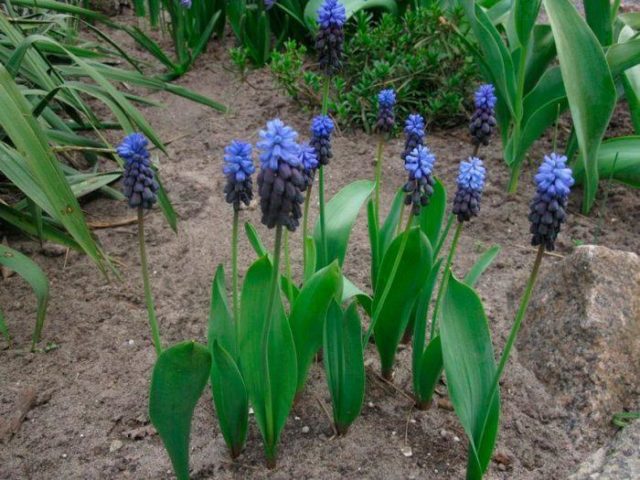

- Pale;
- Crested;
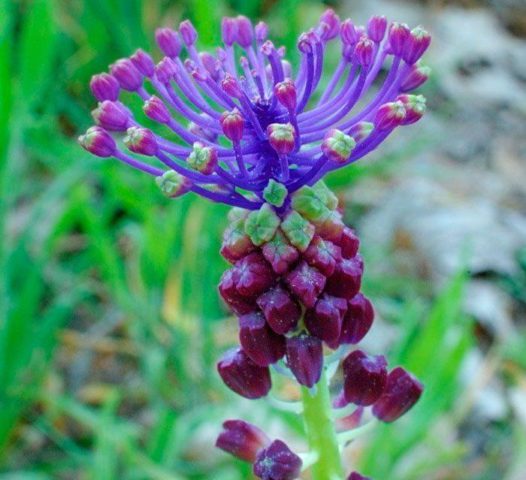

- Osh. White inflorescences are very similar to a group of small bells that are tightly pressed against each other. Osh is one of those flowers visited by the first bees and wasps to wake up after winter. Therefore, it is not recommended to plant a plant near a dwelling;
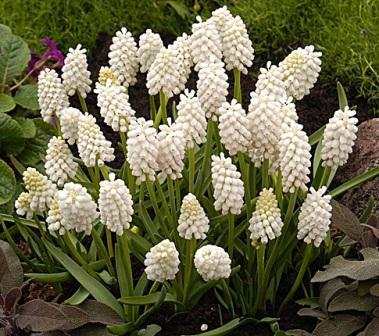

- Pretty. The plant can be planted on alpine hills, it also tolerates poor soils, and, in general, is not demanding to care for. Bulbous perennial is considered one of the most beautiful flowers that can grow on rocky open surfaces.
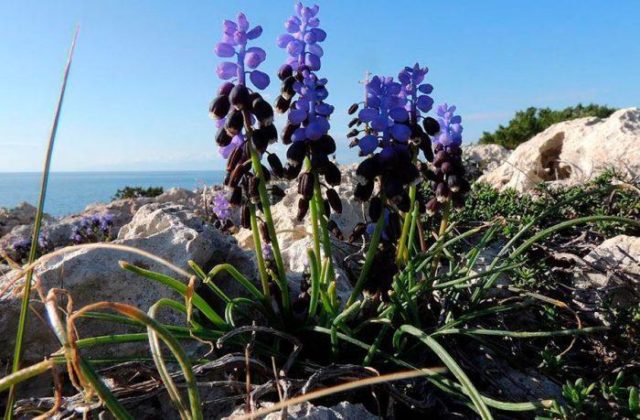

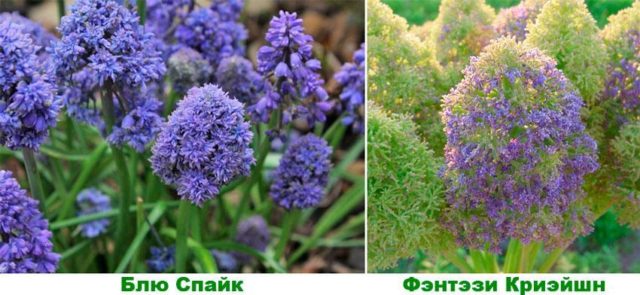

Iris net
The reticulated iris is an early representative of perennial bulbous flowers, which opens its buds in March. To ensure the annual flowering of this type of irises, it is necessary to plant new bulbs every autumn for 3-4 years, and annually dig out the children and plant them again in another place. The tubers should replace each other, since this flower dissolves the buds, and those formed from the baby bulb bloom only after 3 years.
Snowdrop
Galanthus, or snowdrop, is most adored by all growers. Its buds appear along with the foliage, as soon as the snow begins to melt, and continue to delight the eye, despite the dull weather, frost and precipitation in the form of snow.
Among the 18 types of snowdrop, the following varieties are most common:
- Alpine;
- Caucasian;
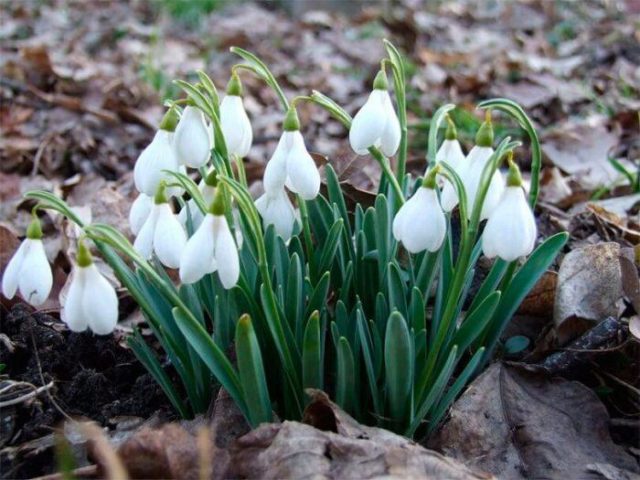

- Bortkevich;


- Cilician;
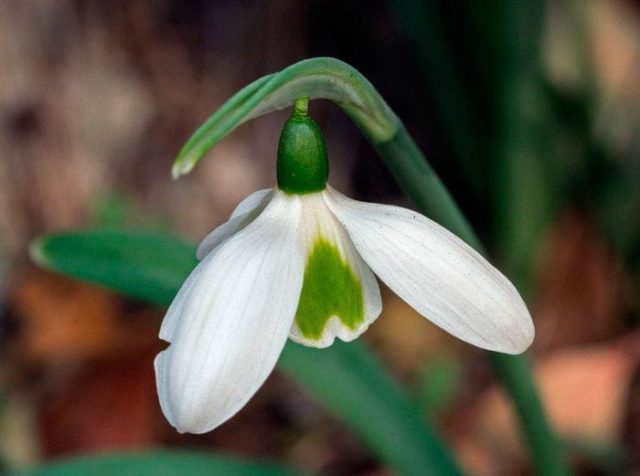

- Folded;
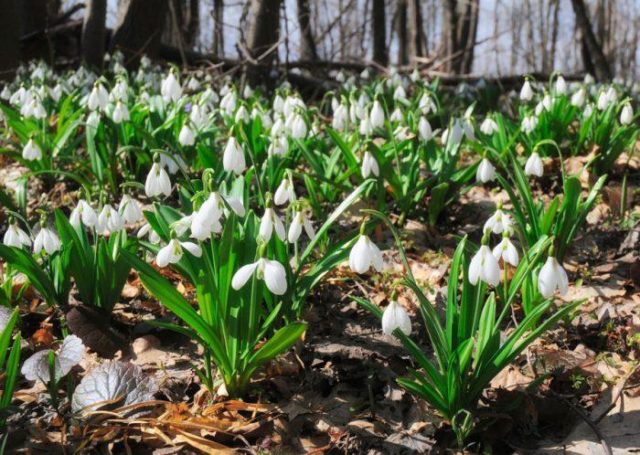

- Broadleaf.
Proleska (scilla)
Scylla, or scrub, is an early flower from the asparagus family that blooms in March. A total of 90 plant species are known, among which the following varieties are more popular:
- Endymion Spanish;
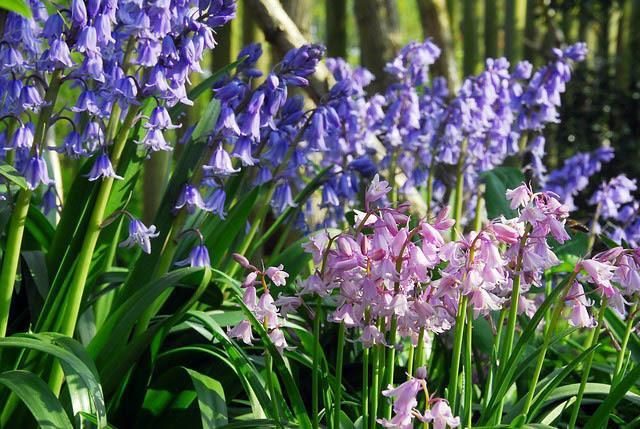

- Double-leaved scrub;
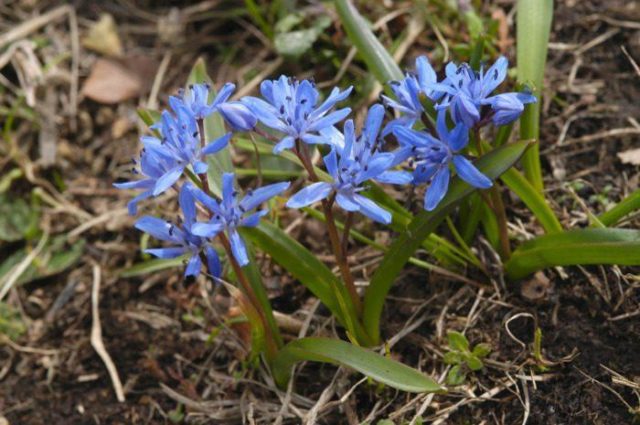

- Peruvian;
- Siberian;
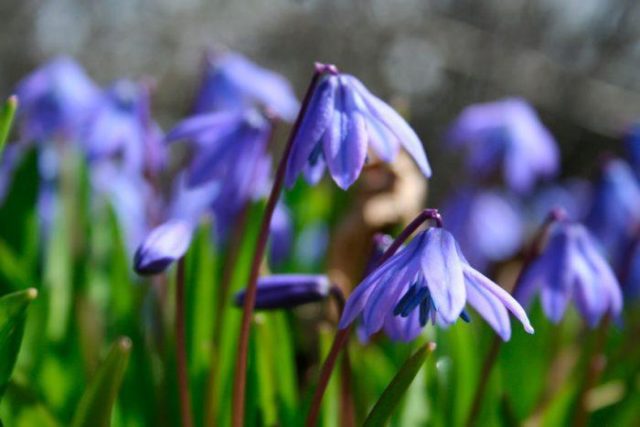

- Armenian.
Solo flowers: who is good at single plantings?
When decorating flower beds, bulbs can act both as soloists, due to their high growth and large inflorescences, and as a background. The highest are gladioli, some varieties of lilies, acidantera, crocosmia. But if the lily is good in a single planting, then it is better to plant the rest in a small group, because their peduncle is narrow and bare to the beginning of the inflorescences.
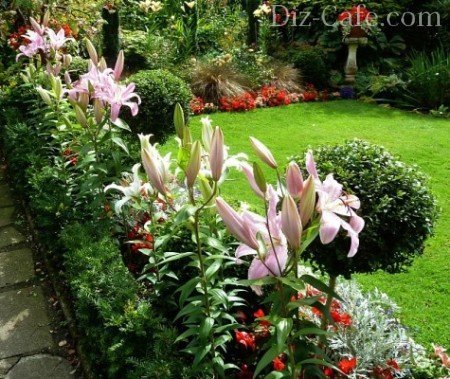

Not every flower in the garden will argue with the beauty of lilies and their high growth, therefore they are given the best places in flower beds
Royal hazel grouses look good in the center of the flower beds. True, it is quite difficult to choose a background for them. These bulbs are among the first to bloom. But among conifers, creeping perennials, climbing plants and ornamental bows, they look really royal. And if planted in a group with a lily, then, while it gains strength and growth, the hazel grouses will have time to bloom and generally disappear, giving way to their followers.
Related article: Planting bulbous flowers in the fall: general rules + an overview of the best 6 varieties
Camellia
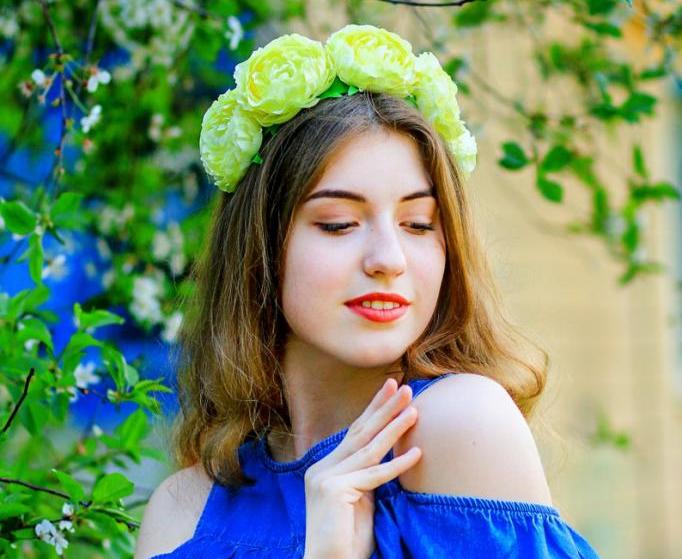

Maybe this is the right option? Like the name of the flower, the name Camellia is taken from Latin.It is very common in the world and extremely rare in Russia, but it is more common among newborns of the last three years than ever.
Women named Camellia have a rather complex character: they are capricious, very vulnerable and almost never know what they want. However, this is only the “surface” of the soul of the owners of the name; for the closest ones, they know how to be not only kind and affectionate, but also very selfless and devoted. And Camellias know how to love sincerely, possessing a huge amount of femininity, tenderness and a romantic mindset.
Jasmine
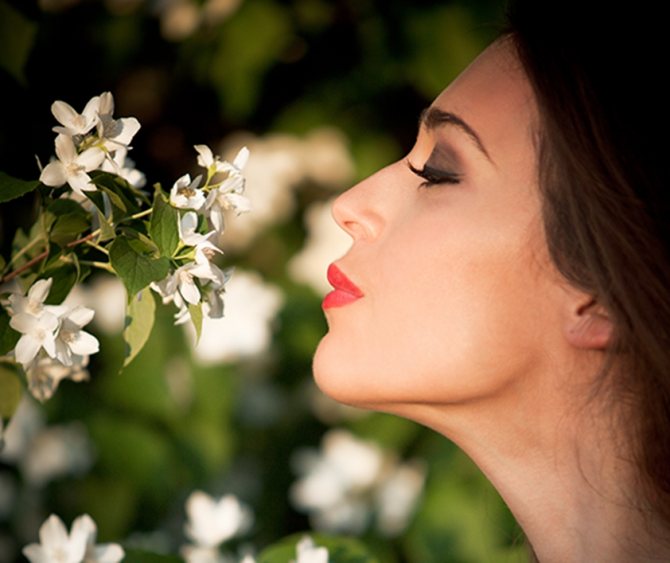

Flower, singer and beloved of Aladdin. The beautiful Persian name Jasmine also refers to forms that are fairly common in the world with a long history. Due to its origin, it is most often associated with oriental women, however, it has been found in our country for several decades.
Women with this name are like the flowers after which they were named: they are sultry, straightforward, fragrant and memorable. Outwardly, they may look innocent and simple, like jasmine flowers, but their soul is like the scent of a flower: it is full, bottomless and magical. With such it is simply impossible to get bored.
The most famous owners of the name Jasmine: the Russian pop singer, the British singer Birdy, as well as the fictional Disney princess from the cartoon "Aladdin".
Colombian aquilegia
Colombian aquilegia, eagle, or catchment is a herbaceous perennial belonging to the Buttercup family. Habitat - Northern Hemisphere (Norway, Iceland, North America). There are about 120 varieties of the catchment area. Shoots have a two-year development cycle. In the first year, buds are laid and a leaf rosette is formed, and in the second, buds begin to bloom. Eagles have different colors: from white to blue. There is also a combination of several shades. The flower-bearing corolla consists of five funnel-shaped petals. The leaves are rounded, bright green. The plant is perfectly cultivated at home.
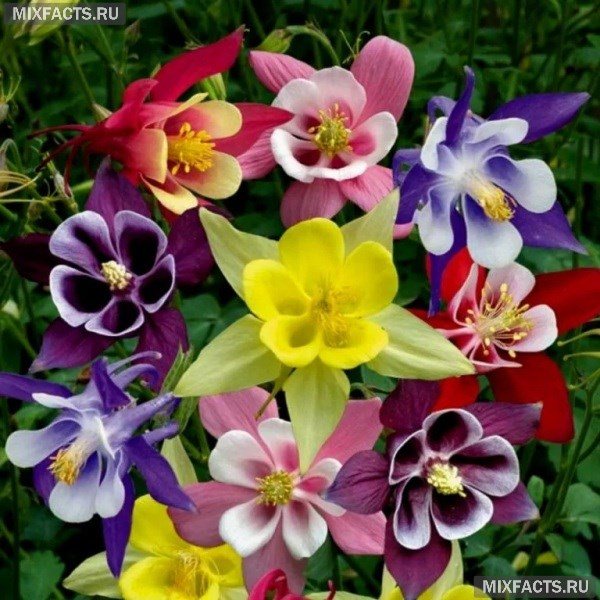

Colombian aquilegia
Kupava
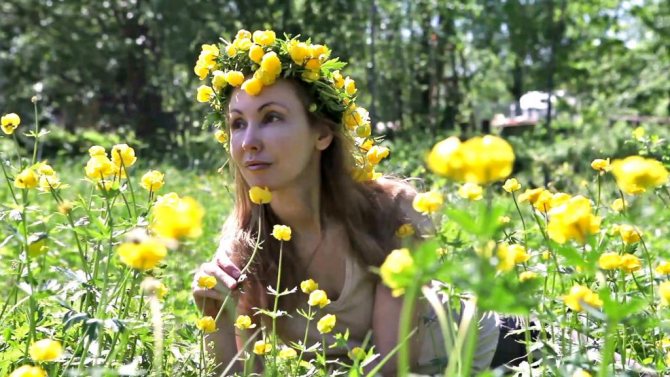

Interested in something fashionable in the old days? The beautiful and unusual Slavic name Kupava comes from the colloquial name for the flowers of the swimsuit. The form was occasionally found in pre-revolutionary Russia, but completely disappeared from use in Soviet times. Currently, the use of the name has revived, however, it is still very, very rare. More often Kupavas are found in Belarus and Ukraine.
By nature, these are very simple, open and naive women. In the male equivalent, they would certainly be called "guy-shirt". What exactly is not in the owners of the name is hypocrisy, greed and envy. They are ready to give their last to those in need, are always happy to keep company and become reliable friends, incapable of betrayal. And the Kupavs very easily find a common language with children and become good mothers.
Passionflower
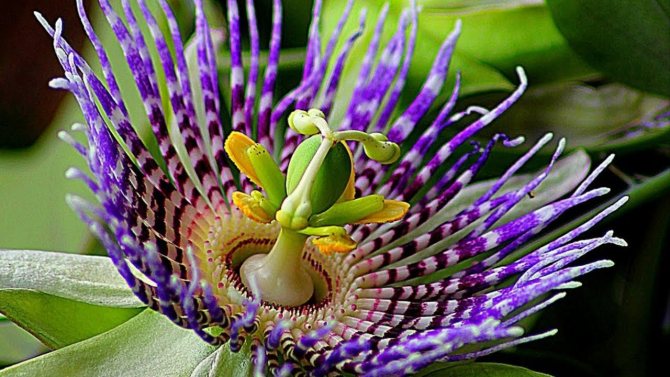

Some of the varieties of passionflower can be recognized by the names of the edible fruits - granadilla and passion fruit
She's a passionflower and a cavalry star. It grows in South America, Asia, Australia and has tasty fruits, as well as bright flowers 10 cm in diameter. This is a liana that is beautiful and unpretentious. Thanks to these qualities, she is happily bred at home. It is important to remember that the germination of passionflower seeds depends on how long ago they were removed from the fruit. Better to plant by reaching just before planting. In order for the plant to delight in the future with both flowers and berries, proper pruning is required.
Protea
The unusual appearance of the proteas is given not by the flowers themselves, but by their leafy wrappers, painted in yellow, pink, blue-pink colors.
This plant is considered one of the most beautiful on Earth among those that are able to bloom. His homeland is the African continent.An amazing feature of the exotic flower is that it contains an incredible amount of nectar, for which the protea was nicknamed "a barrel of honey".
The flower lends itself to cultivation and cultivation in the conditions of Russia. In mild climates, the plant can become a garden perennial, and in a more severe climate it will decorate a greenhouse or at least a windowsill. For this it is important to provide warmth, plenty of light and fresh air.
Protea is the most popular and beloved plant in South Africa. One of its species - the royal protea - is considered a symbol of South Africa.
Decorative bows (alliums): beautiful in group plantings
Ornamental bows are a numerous group of bulbous plants for the garden. More than 150 varieties of them have been bred, but for some reason alliums are used much less often in the design of flower beds of tulips or gladioli. But in vain! These plants have very compact tubular leaves forming a bush, and the number of flowers per plant reaches 60 pieces. Ornamental bows have a long growing season, so they will look beautiful all spring and summer, even if the flowering period has not yet arrived. Varieties differ in flowering time. Early onions begin to bloom by mid-May, and later ones - at the end of August, and the duration of flowering is a month or more.
It is good to decorate the edge of the border with these bulbs, the lower tiers in multi-stage flower beds, and include them in mixborders. And, for example, the chives variety can also be eaten. In spring, its thin tubes come out of the ground very early, even outstripping winter onions, so you will get a double pleasure - both aesthetic and nutritional.
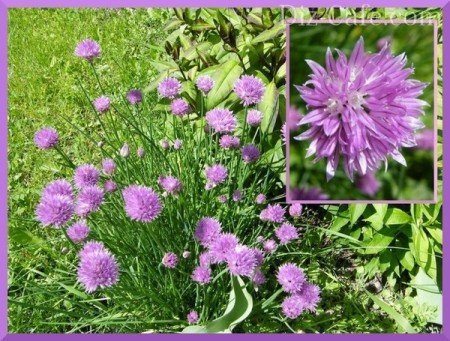

Schnitt onions, whose feathers you did not have time to eat in early spring, will give out beautiful lilac inflorescence balls by summer, decorating a garden or flower bed
Play of colors
The selection of colors depends on the appearance of the house.
The colors are warm and cold. To obtain contrasting combinations, cold and warm shades should be combined. To achieve harmony, colors are used that are close in tone. Almost every garden uses white colors.
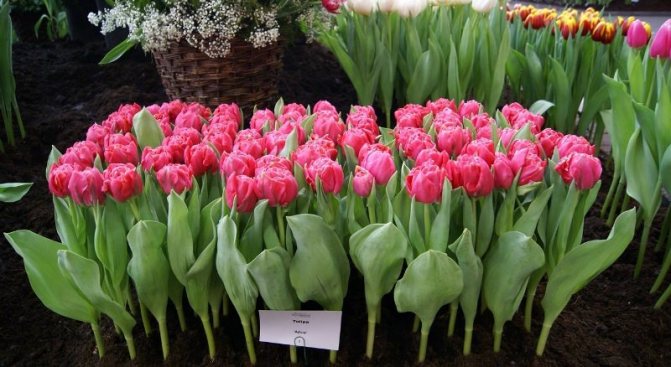

The same color scheme should be used in every corner of the garden so that there is no oversaturation.
The basic rule is to apply no more than 3 shades. There is one more nuance - harmony is achieved with a color ratio of 70:15:15.
Plants in need of special living conditions
In pursuit of growing large inflorescences, breeders do not always take into account the degree of stem thickness. And many of the newer bulbous varieties have huge flowers but slender stems. This, of course, looks gorgeous on a flower bed when the weather pleases with warmth and calm. But if the rainy season falls at the time of flowering or a strong wind rises, all beauty will instantly fall to the ground, because the thin stem will not withstand the swinging or the wet, heavy inflorescence. This can happen with many varieties of terry daffodils and freesias.
Recent Entries
Rose Petal Jam and Its 7 Health Benefits You Likely Didn't Know About What Fruit Are You According to the Zodiac Sign 11 Best Grape Varieties That Will Help You Create Unique Homemade Wine
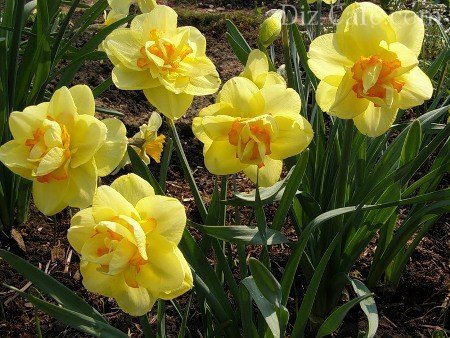

The more petals in the inflorescence of terry daffodil, the faster it gets wet and weighs heavily on a thin flower arrow
Gladioli often break, but not because the stem is weak. On the contrary, a powerful flower arrow with an abundance of large inflorescences becomes a heavy burden on the bulb. And it is at the point of the beginning of the growth of the stem that breaking out occurs during windy weather. Therefore, many plants with tall stems will have to be tied up as soon as flower stalks begin to be released. You can, of course, immediately plant bulbs near a net or a fence, but not every site has such a place. By the way, a very close "relative" of gladiolus - acidander - is absolutely not afraid of the winds. However, only one flower is released.
Black eyed suzanne
Black-eyed Suzanne, or Tunbergia, is a wild annual shrub, often growing in the form of long, branching bindweed. The natural habitat is concentrated on the island of Madagascar and in many countries of South Asia. In the modern flora, there are about 200 varieties of tunbergia. Basal multi-lobed rosettes with yellow blotches and a dark core, upright erect stems with rough leathery rhomboid leaves are the main distinctive features of tunbergia. These flowers are propagated by seeds, and some varieties are propagated by dividing the rhizome.
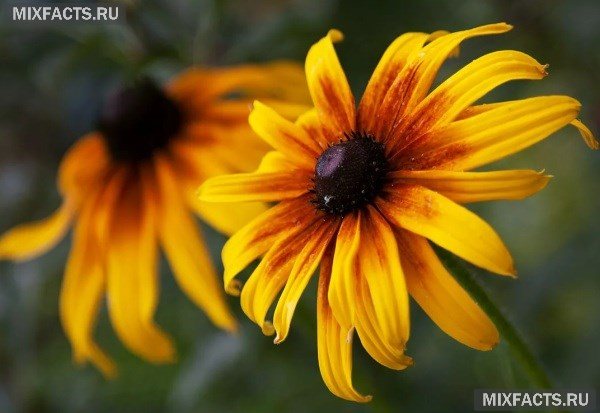

Black eyed suzanne
Viola
A wonderful and gentle option. The name Viola owes its origin to the Latin name for violets. It is not very common in Russia. However, in the rest of the world it is one of the most popular "flower" names, along with Lilies and Roses.
The owners of this form are very pleasant and sweet women. They have a rich imagination, a vulnerable soul and a very strong love for nature, and therefore for Viola there is no better rest than a walk in the forest or river bank. As with fragile violets, Viols should be handled very carefully: they are easily upset. Feeling resentment, this woman will simply close; it will be practically impossible to re-gain her trust.
Famous Viols include American actresses Davis and Lynn Collins, as well as Viola Tarakanova, a fictional character in a series of detective novels by Daria Dontsova. In the film adaptation of the books, her role was played by actress Irina Rakhmanova.
Names derived from color names
- Azhar, Azhar (Arabic) - flowers, bloom
- Algoma (North American Ind.) - Valley of Flowers
- Anthia (English) - flower
- Virineya (lat.) - green, fresh
- Gulistan (pers.) - flower garden
- Gul (pers.) - flower blooming
- Gulnara (pers.) - decorated with flowers
- Kalantia (eng.) - a beautiful flower
- Liana (English) - graceful meadow
- Luludi (gypsy) - flower
- Poleva (Slav.) - field
- Flora (lat.) - the name of the Roman goddess of flowers
- Fleur / Flo (English) - flower
- Florella (lat.) - blooming
Use the Service of choosing a name from the site in order to find the most suitable name for your baby.
photo: depositphotos
Licoris
In its homeland, lycoris has more than 20 different subspecies, while only six have been imported to Russia.
A perennial plant of the bulbous family attracts attention with its bright color. Interesting fact: the flower never "meets" the leaves, as it grows on a separate stem. The birthplace of lycoris is Japan and China, where the plant is considered the "flower of the dead" and for this reason is never planted near the house.
Russians, alien to prejudice, use it as a garden and indoor decoration. An oriental guest requires a temperature not higher than 20 ° C, a drained sandy soil, a special irrigation and lighting regime.
Practice shows that in our climatic conditions these flowers easily take root in the partial shade of large deciduous trees, read about this:
Lantana
Lantana is a dicotyledonous flowering plant included in the Verbenaceae family. In nature, lantana can be found in the tropical regions of South America, Africa and Asia. About 130 species of lantana were counted. Each of them is a shrub or semi-shrub with branches covered with small thorns. Peduncles are collected in head-shaped inflorescences of a semi-triangular shape. The leaves are located opposite, have a specific pungent odor. The shade of the petals is incredibly varied: pink, yellow, orange, red, purple.
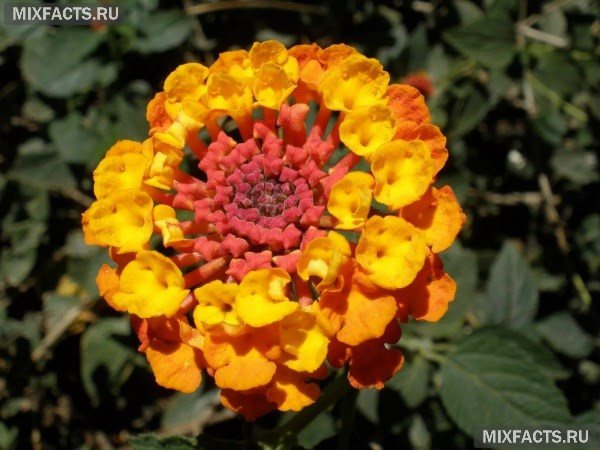

Lantana
Lily
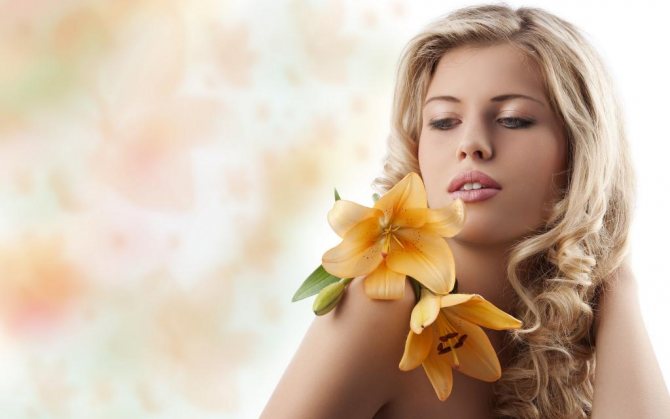

The female name also comes from the Latin name of the flower of the same name. In different nations, it is associated with purity, tenderness and fragility. These are the owners of the name by nature, however, it is worth remembering that lily flowers have a very specific aroma, which can even make your head ache.This specificity is also present in the character of Lily - these are very spontaneous and mysterious women, sometimes who seem simply strange to others. However, these traits only attract attention to the Lilies, charming many.
Celebrities named Lilia include: British writer Lillian Ethel Voynich, Russian Mayakovsky muse Lilya Brick, American actresses Lillian Gish and Lily Collins, English singer Lily Allen.
Vasilisa
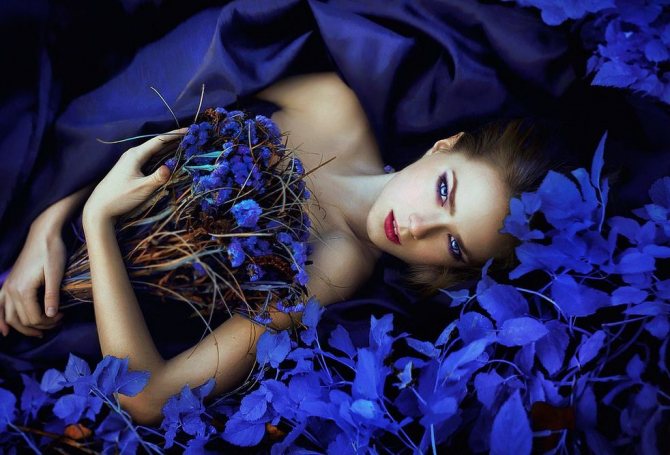

And another similar name. In its translation, the name Vasilisa, like the male counterpart Vasily, is in no way connected with the sky-blue wildflowers of cornflowers. The name comes from the Greek language and is translated as "regal" (the Greek word "basilias" is translated as "king"). The name is very common in Russia, and because of folklore associations it is often mistakenly considered Slavic, and therefore associated with the Russian folk wildflower.
However, in the character of a woman with such a name, there is nothing of cornflower-blue simplicity. Vasilis are truly regal, very stately and with high self-esteem. They are very smart, calm, kind, but not naive, they never allow themselves to be used, they rely only on themselves in life.
Among the famous Vasilis: the fictional heroines of many Russian fairy tales Vasilisa the Beautiful and the Wise, the heroine of the play of the same name by Maxim Gorky Vass Zheleznova, the Russian TV presenter and astrologer Vasilisa Volodina.
Rafflesia
Rafflesia bloom for no more than 4 days and attract flies with their "aroma"
She is a "cadaveric flower". This is a parasitic plant without stems and leaves, with flowers 60–100 cm in diameter and weighing more than 10 kg, which emit the smell of ... rotten meat.
Rafflesia grows in rainforests and is not suitable for domestic breeding. Numerous attempts to obtain it in a greenhouse almost always ended in failure.
Dahlia
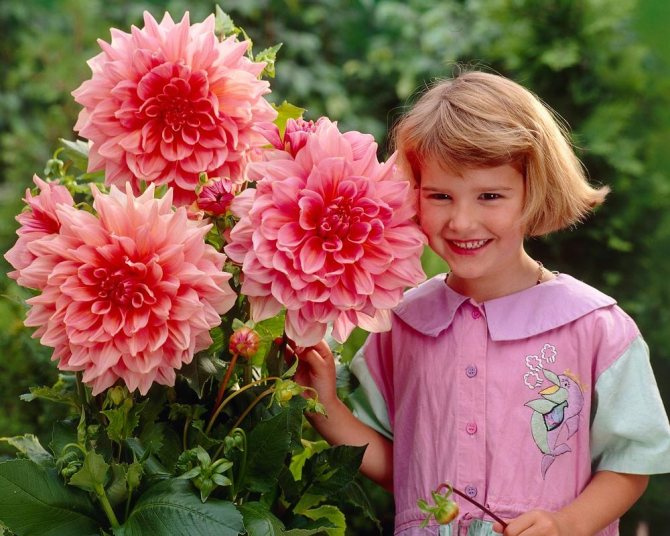

The name of Dahlia, such as Camille, is consonant with the name of the flower, but does not imply it. Both in Russia and in the rest of the world, Dahlia (as well as Zhorzhina, Georgia and Yorgina) is the female version of the international name Georgy (Georges, George). Like the male ancient Greek counterpart, it means "farmer" in translation. And only in Russia it is associated with a flower, which was named after the name of the Russian scientist of German origin Johann Georgi. Throughout the rest of the world, dahlias are known by their Latin name dahlia.
By nature, Dahlias are very lively, cheerful and somewhat courageous. They are characterized by straightforwardness, courage and strength. These women know how to be their own in any company, have oratorical talent, love sports and competitions. Even in ordinary life, they are able to improve only in a state of passion, trying to overtake others.

